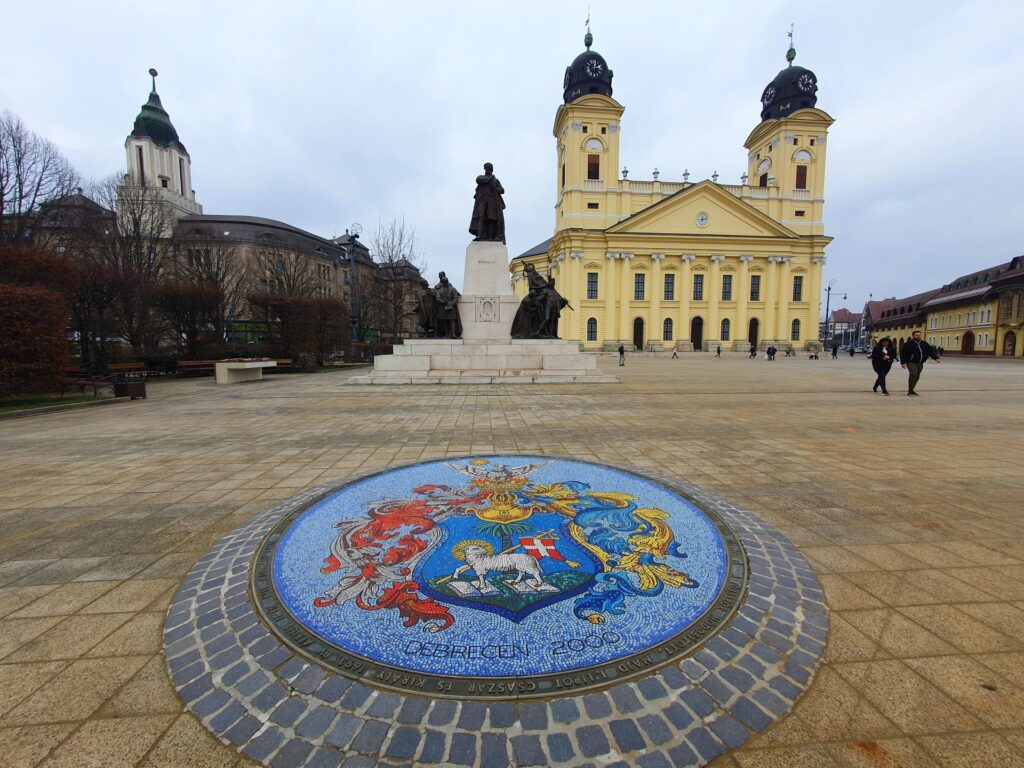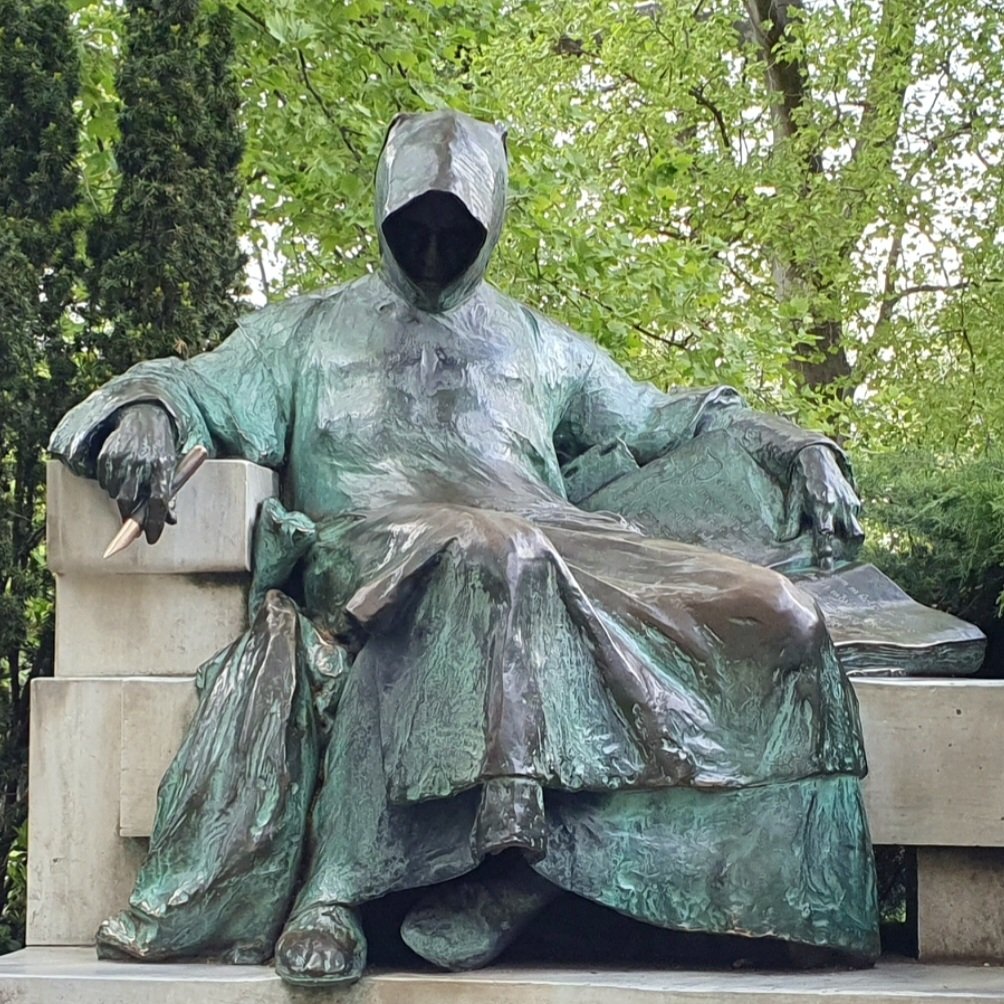Debrecen (Debrezin in German, Debrețin in Romanian) is Hungary’s second largest city and the seat of Hajdú-Bihar County. It was the largest Hungarian city in the 18th century, former capital of Hungary (in 1849 and then in 1944), and nowadays an important academic, cultural and economic center. The Hungarian Declaration of Independence from Austria has been presented by Lajos Kossuth in the Great Calvinist Reformed Church of Debrecen on the 14th of April 1849. Here are some of the main sights of the city. Enjoy the article and, if you wish, share it!
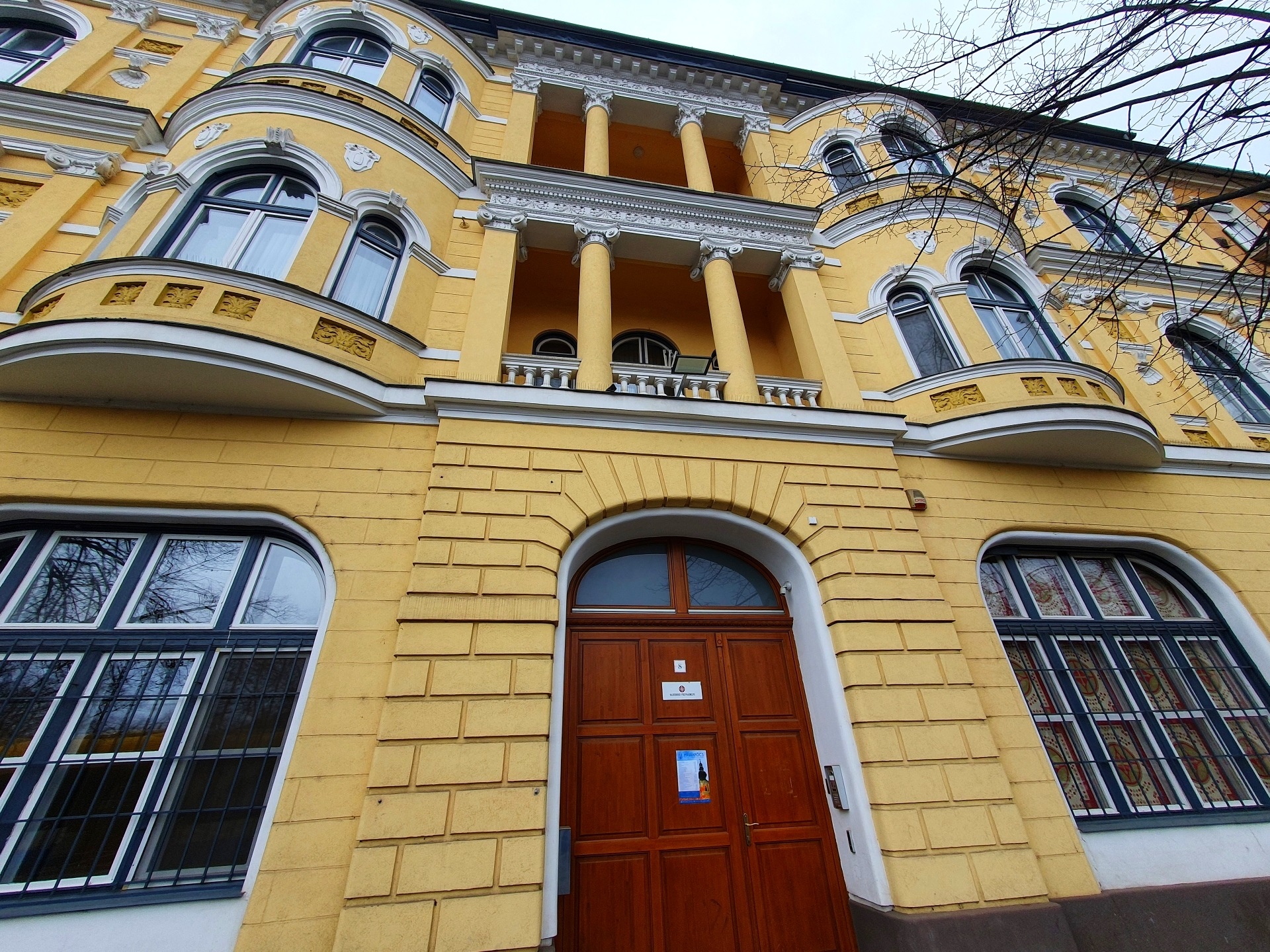
We begin our journey from where we left the last time, that is, the Debrecen Railways Station or Vasútállomás. Here is the Greek Catholic Metropolitan Office or Görögkatolikus Metropolitai Hivatal.

This is the County Government Office of Hajdú-Bihar or Hajdú-Bihar Vármegyei Kormányhivatal in Megyeháza. To the left is the Hungarian Directorate-General for Social Affairs and Child Protection (the Szgyf Hajdú-Bihar County Branch) or Szgyf Hajdú-Bihar Megyei Kirendeltsége.
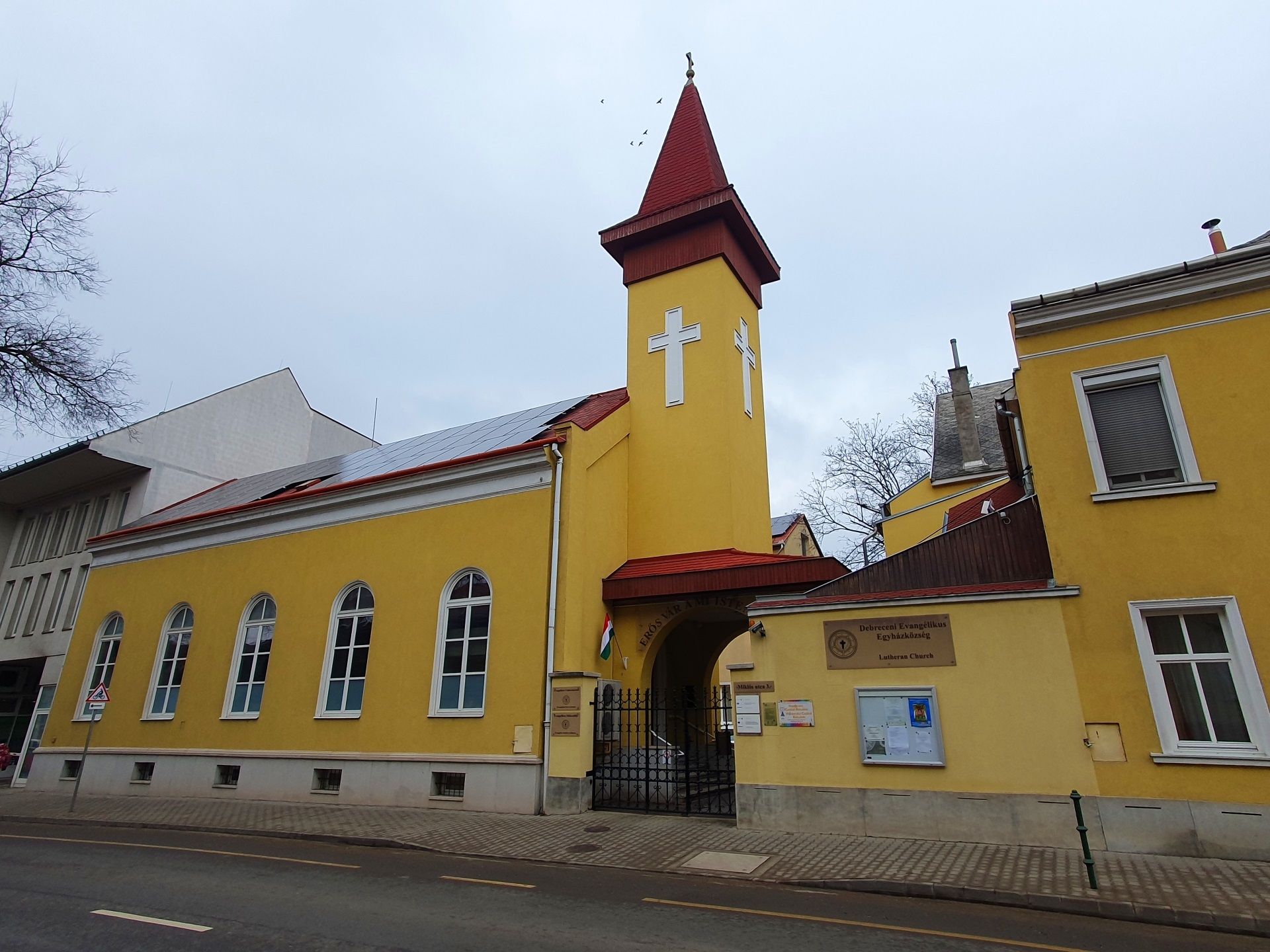
The Debrecen Evangelical Pastor’s Office or Debreceni Evangélikus Lelkészi Hivatal.
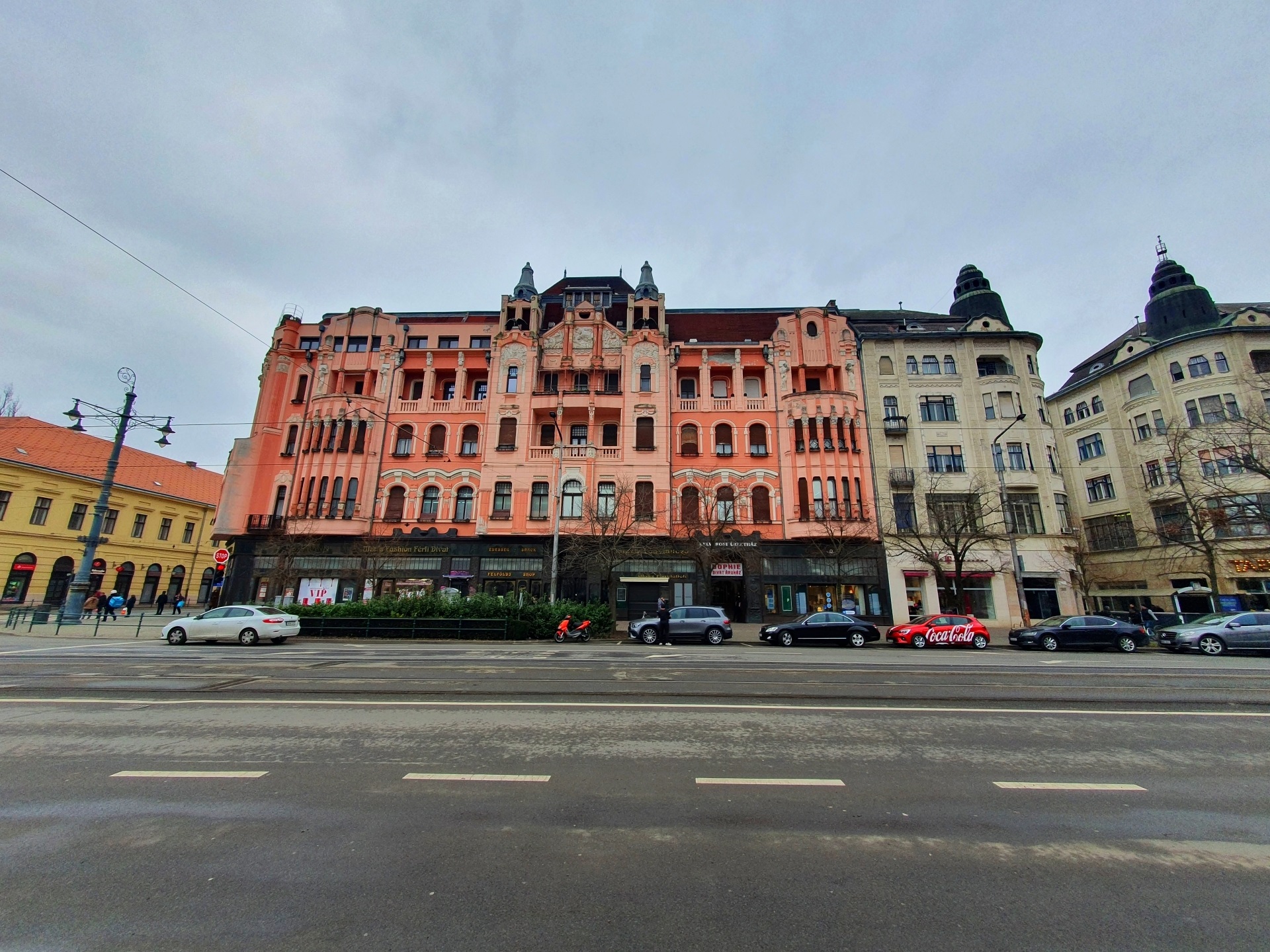
The Downtown Community House or Belvárosi Közösségi Ház, built in the Art Nouveau style, a reminiscence from the buildings of Oradea (Nagyvárad).
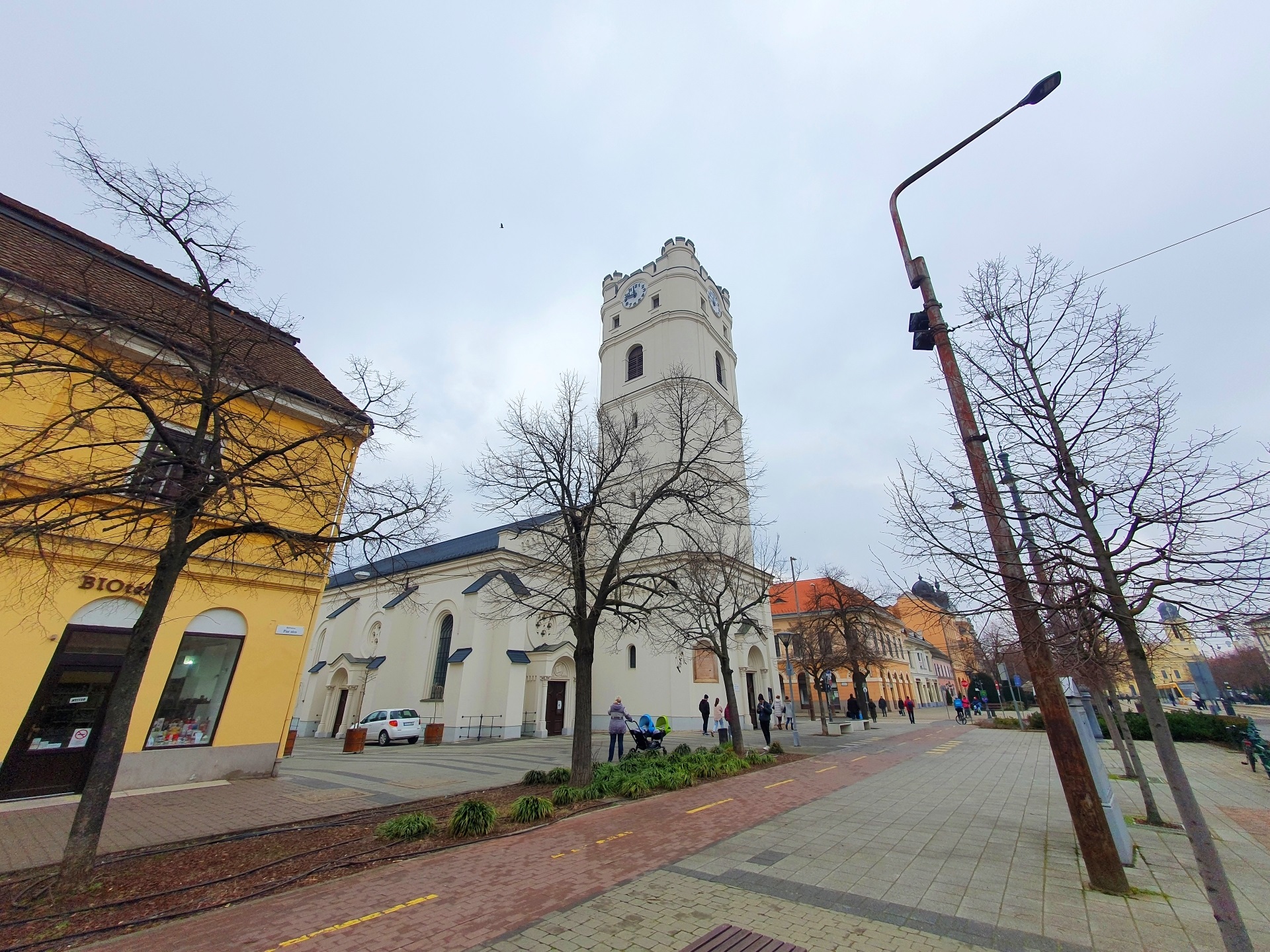
The Small Reformed Church of Debrecen (the Csonka Church) or Debreceni Csonka Református Kistemplom, across the street.
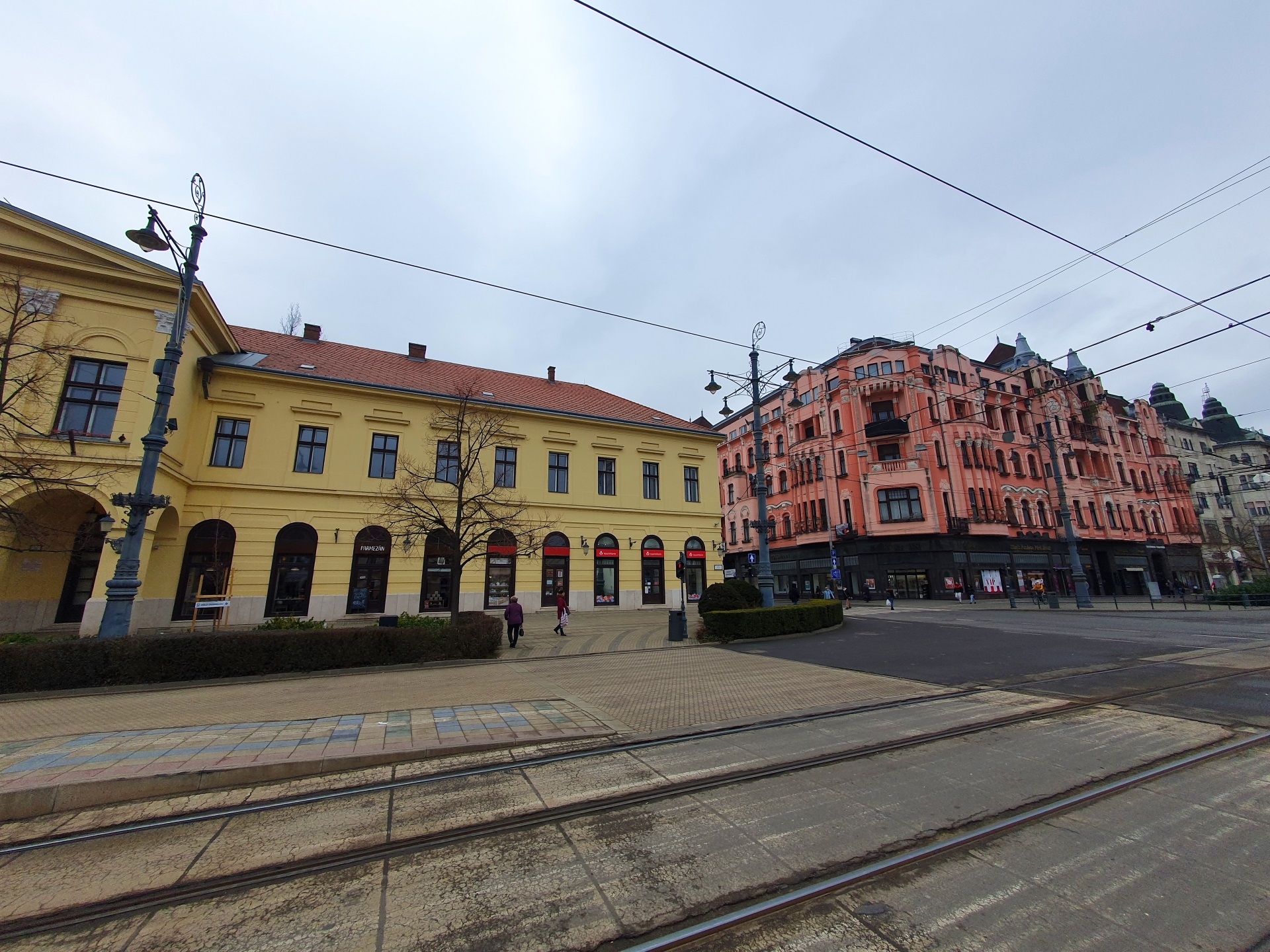
An important crossroad, to the left is the Debrecen Tourist Information Center, part of the town hall building.
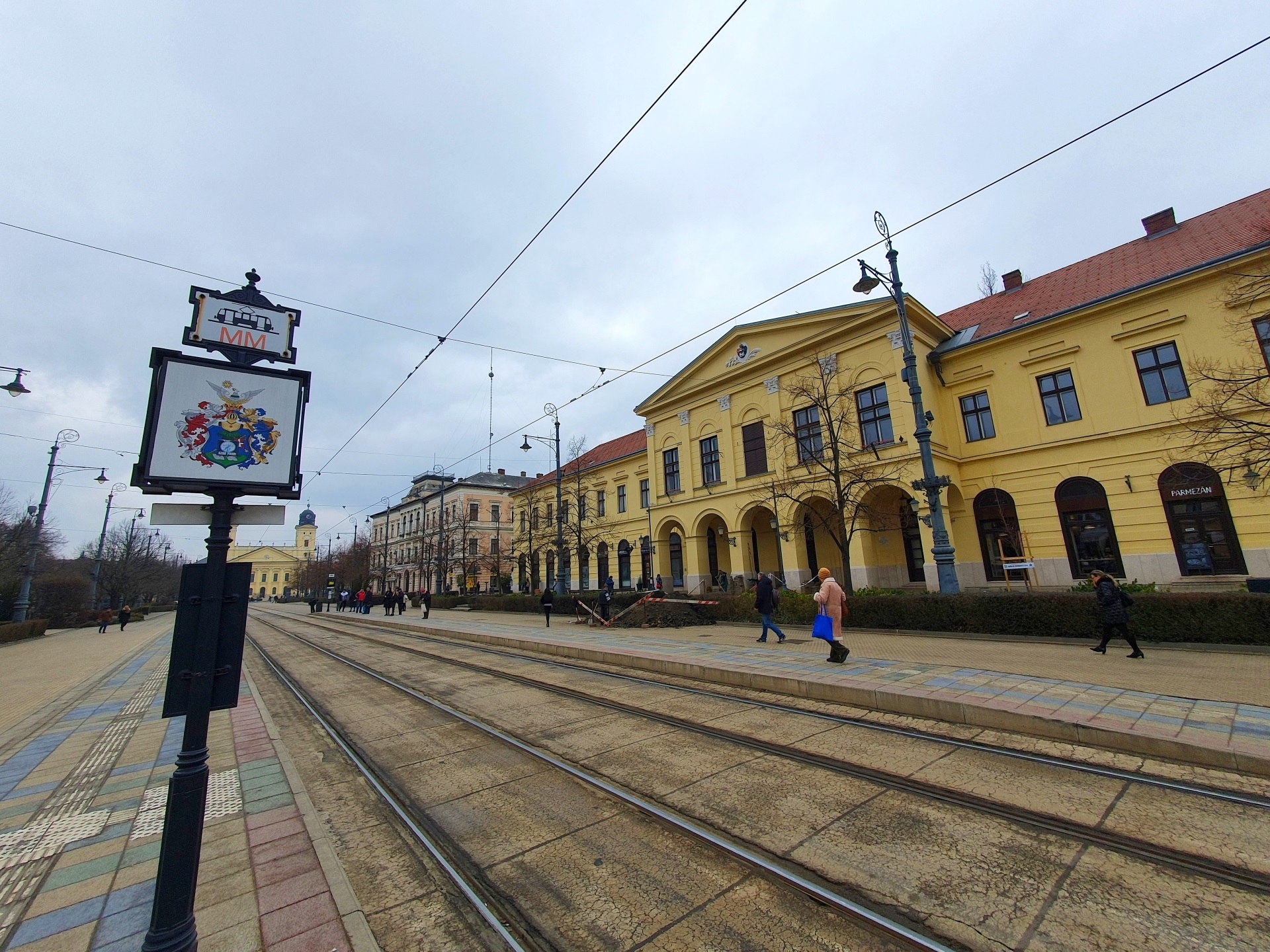
Debrecen County Mayor’s Office or Debrecen Megyei Jogú Város Polgármesteri Hivatal. Far to the left is the main cathedral.
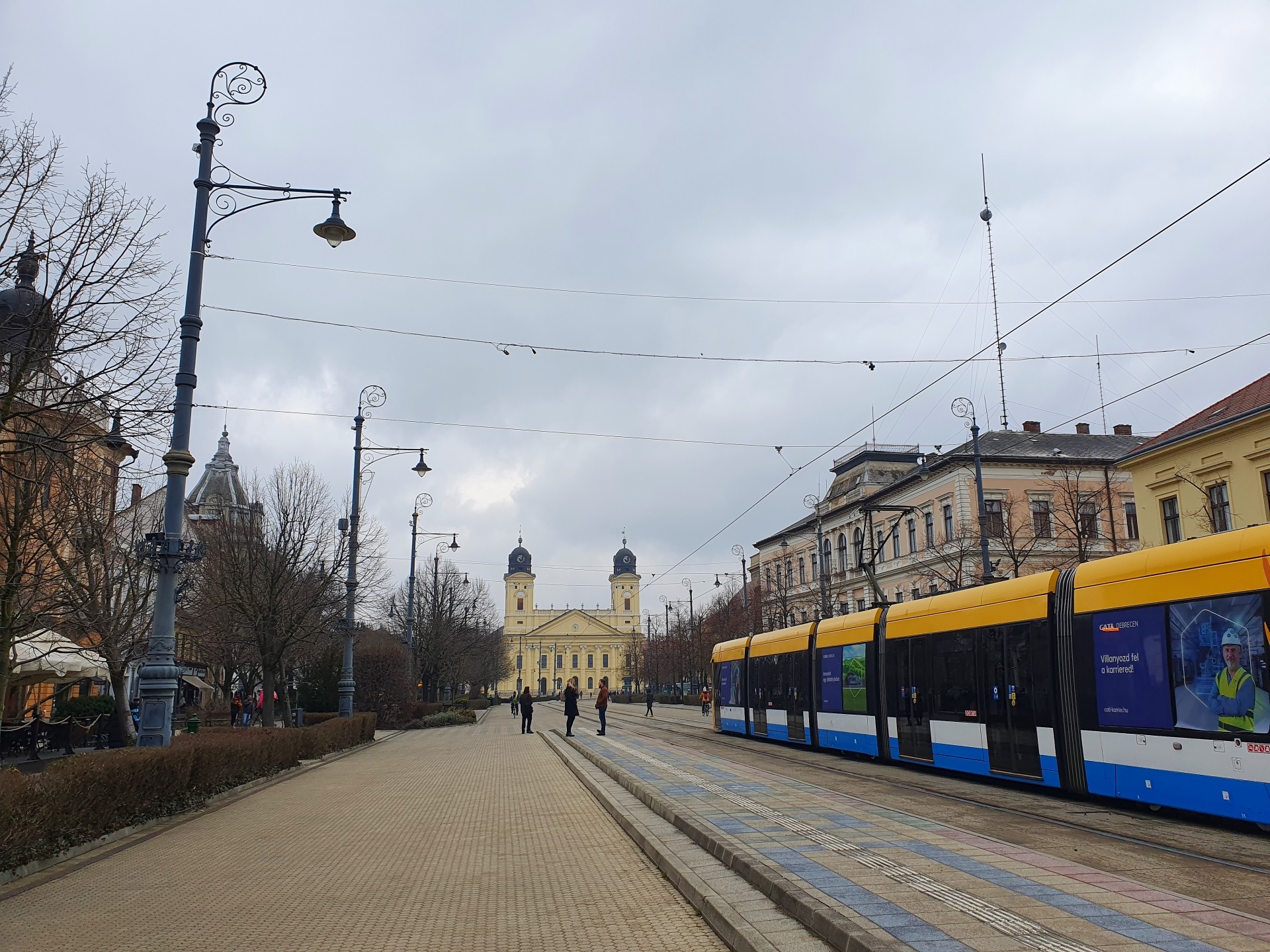
A better view with the local tram to the right, partially blocking the view to the MÁV Office Building.
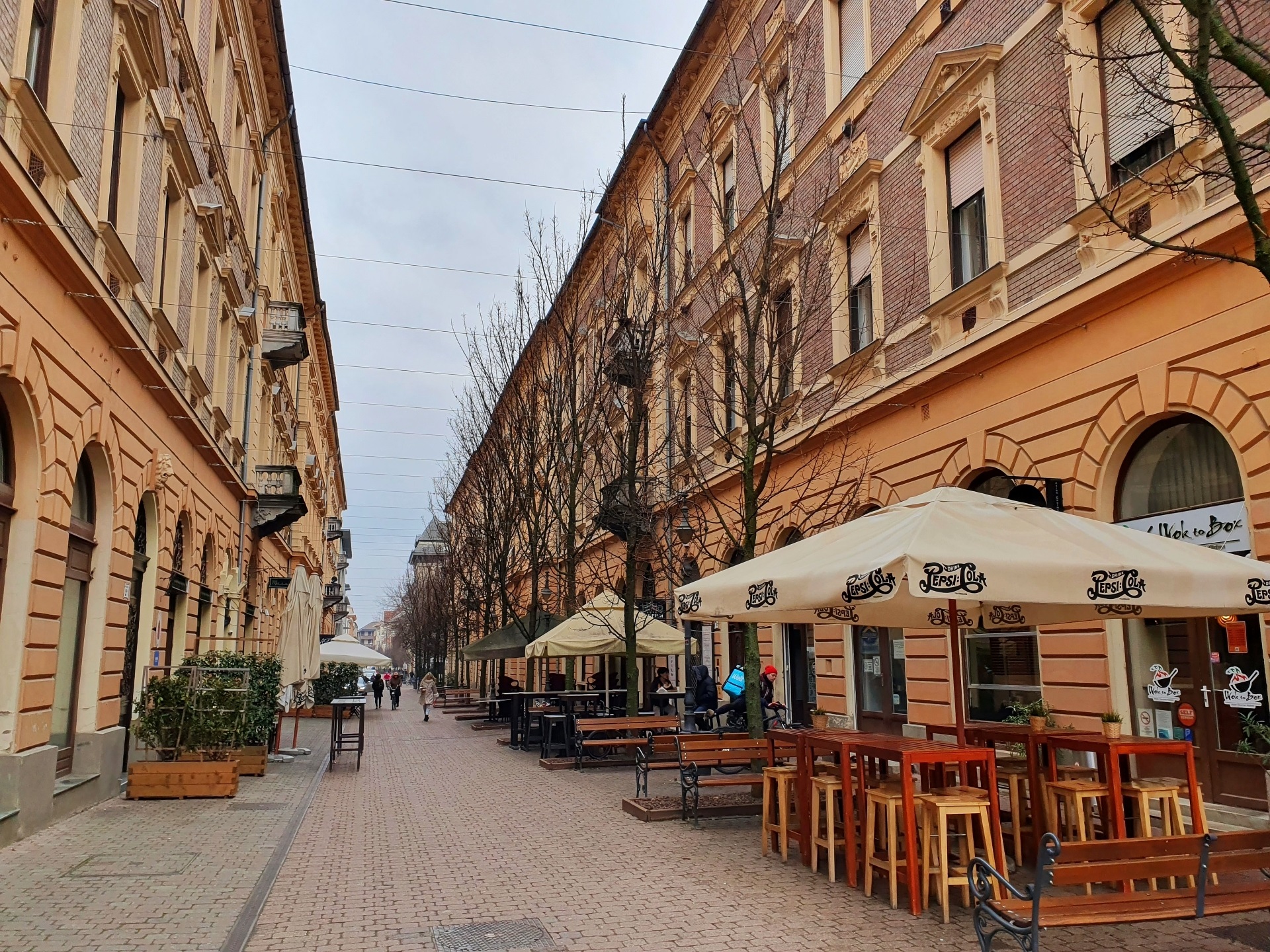
The Simonffy pedestrian street or Simonffy sétáló utca.
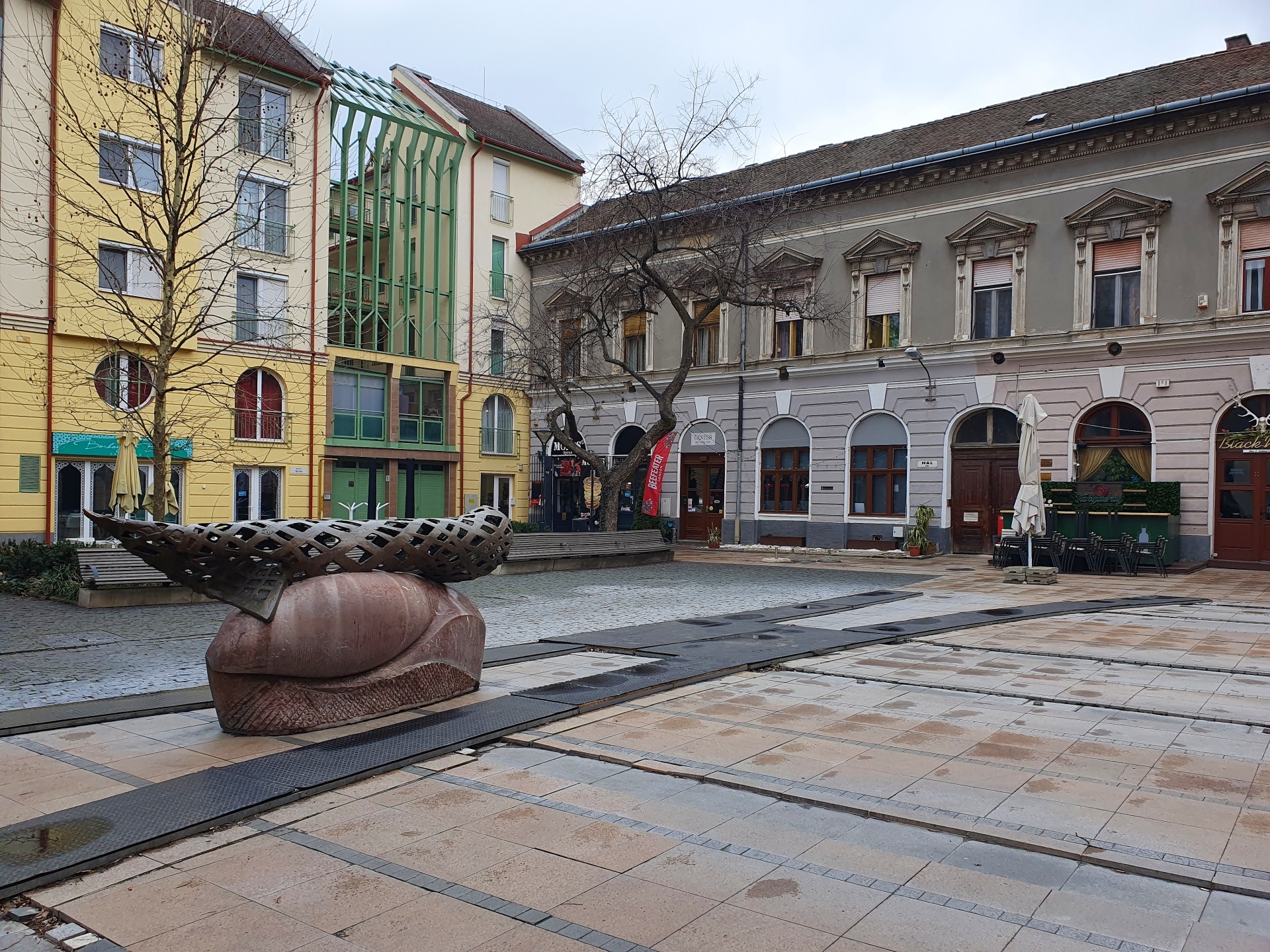
Halköz Square (Halköz tér) with a peculiar monument in its midst.
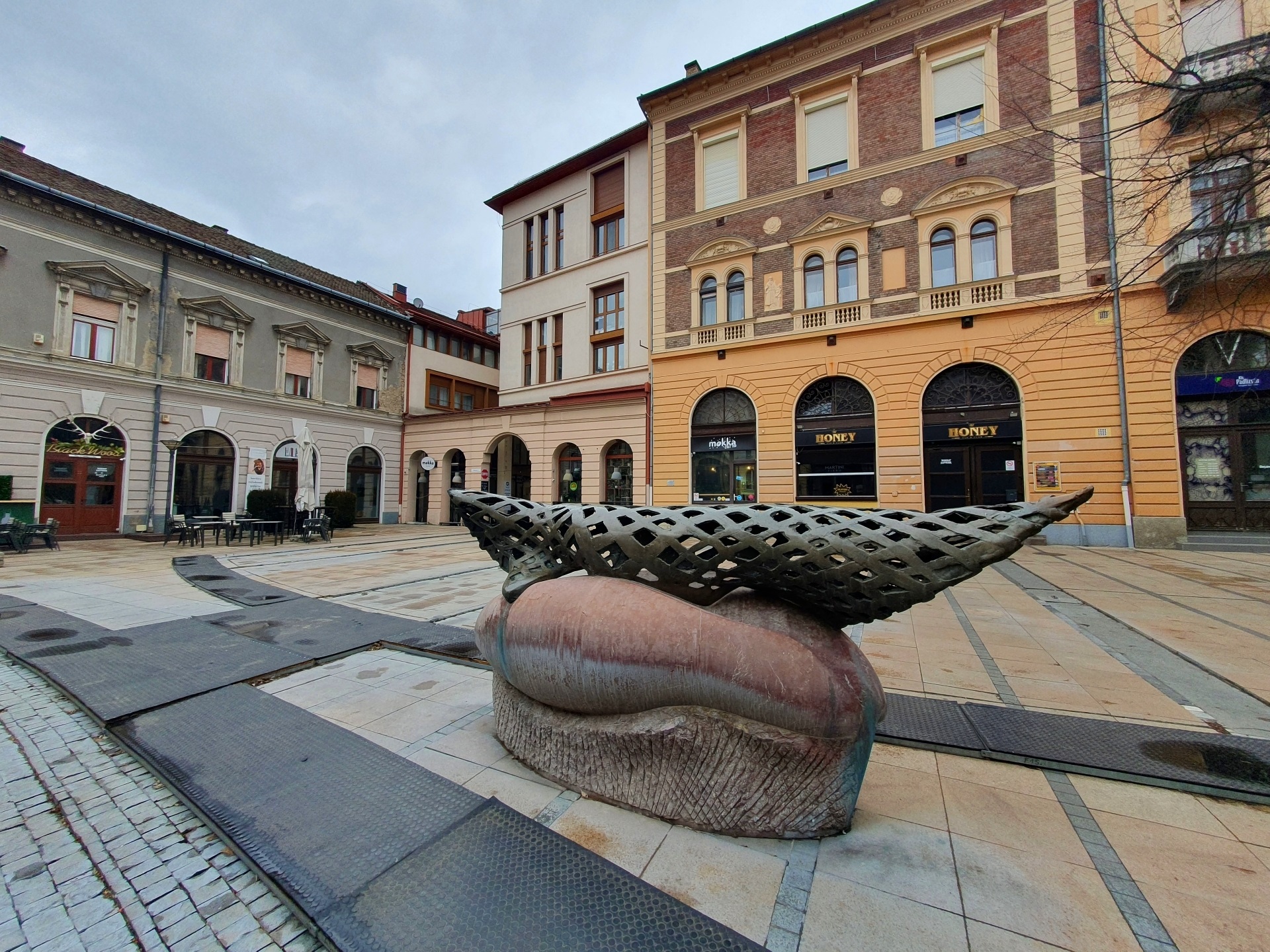
Sesztina Art Gallery in the same square (I think I saw some masonic symbols on its façade but maybe I’m wrong).
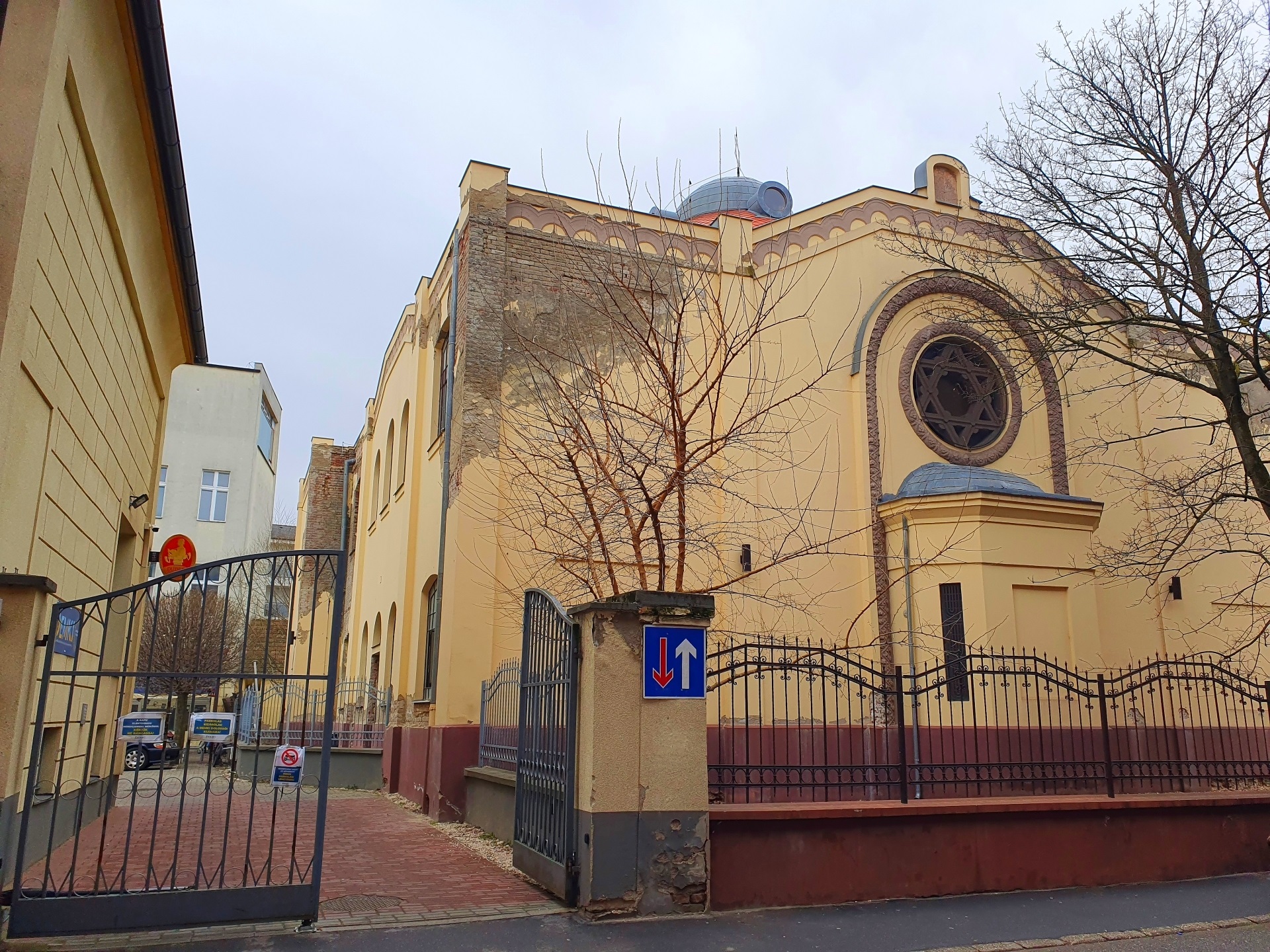
Debreceni Zsinagóga – the local synagogue, quite ruined if you ask me…

Another view of the same synagogue from the Israelite Community of Debrecen building or Debreceni Izraelita Hitközség.
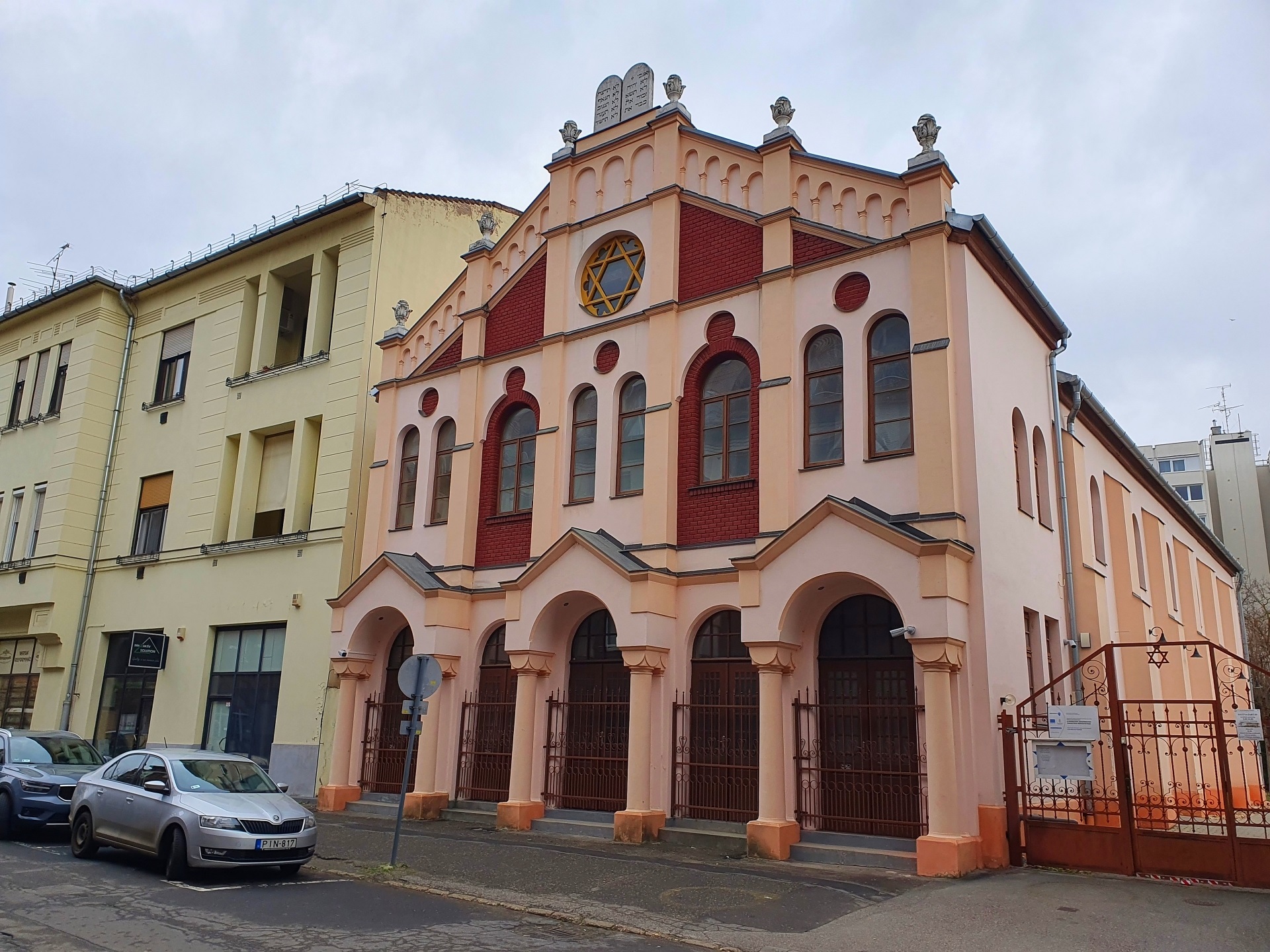
A better-looking synagogue, the smaller Pásti Street Orthodox Synagogue or Pásti utcai zsinagóga.

Back to the main Kossuth Square (Kossuth tér), looking back towards the Vasútállomás. To the right is Mathias Corvinus Collegium and, close and behind the electronic clock/calendar, is Debreceni sárhíd, the remnant of the former mud bridge that went from the Great Cathedral to Kossuth Street (a wooden bridge that made traffic possible on Debrecen’s main street for two centuries from the 1600s).
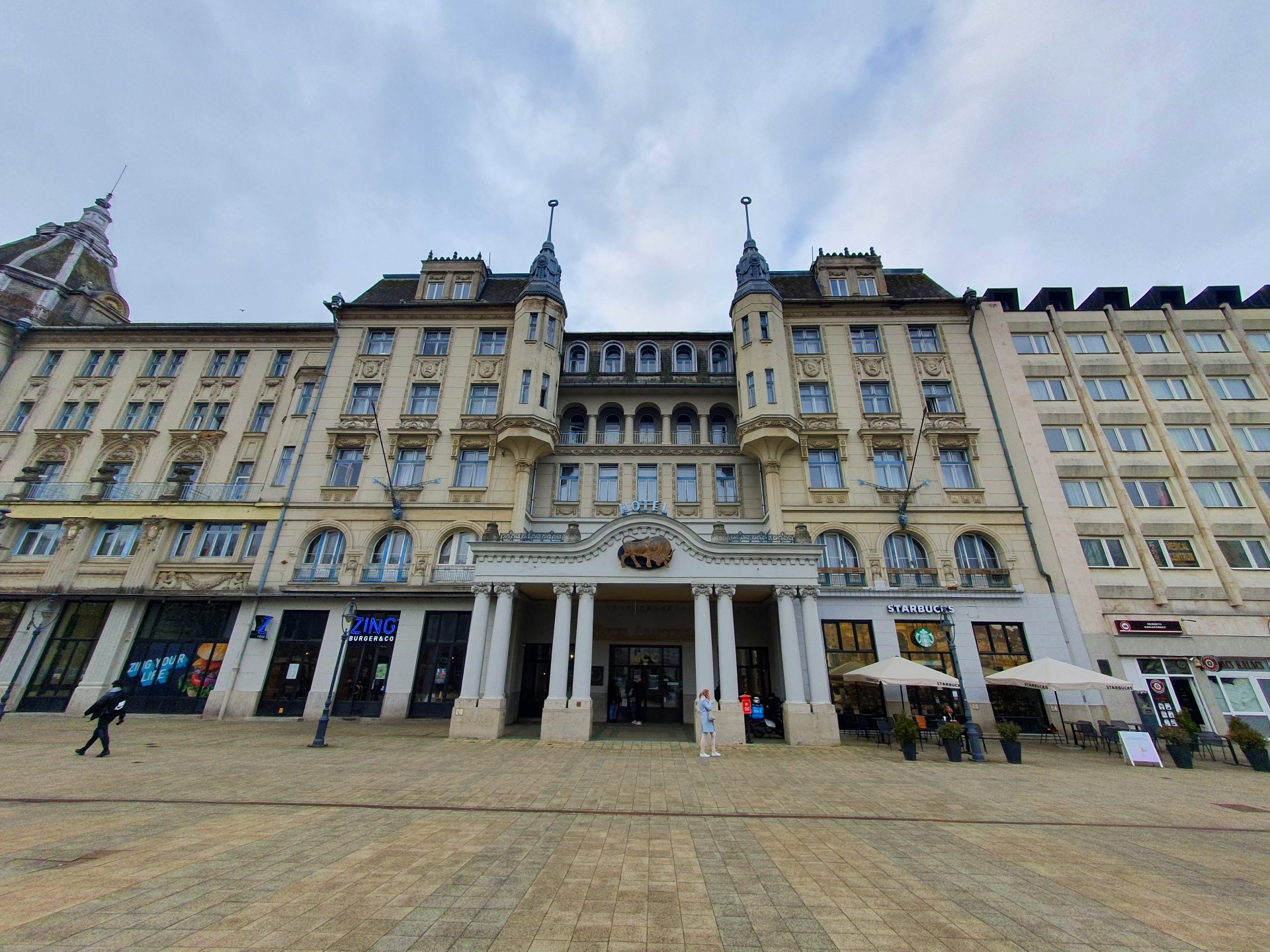
The entrance to Mathias Corvinus Collegium but also to Vig Mozi (a movie theater).
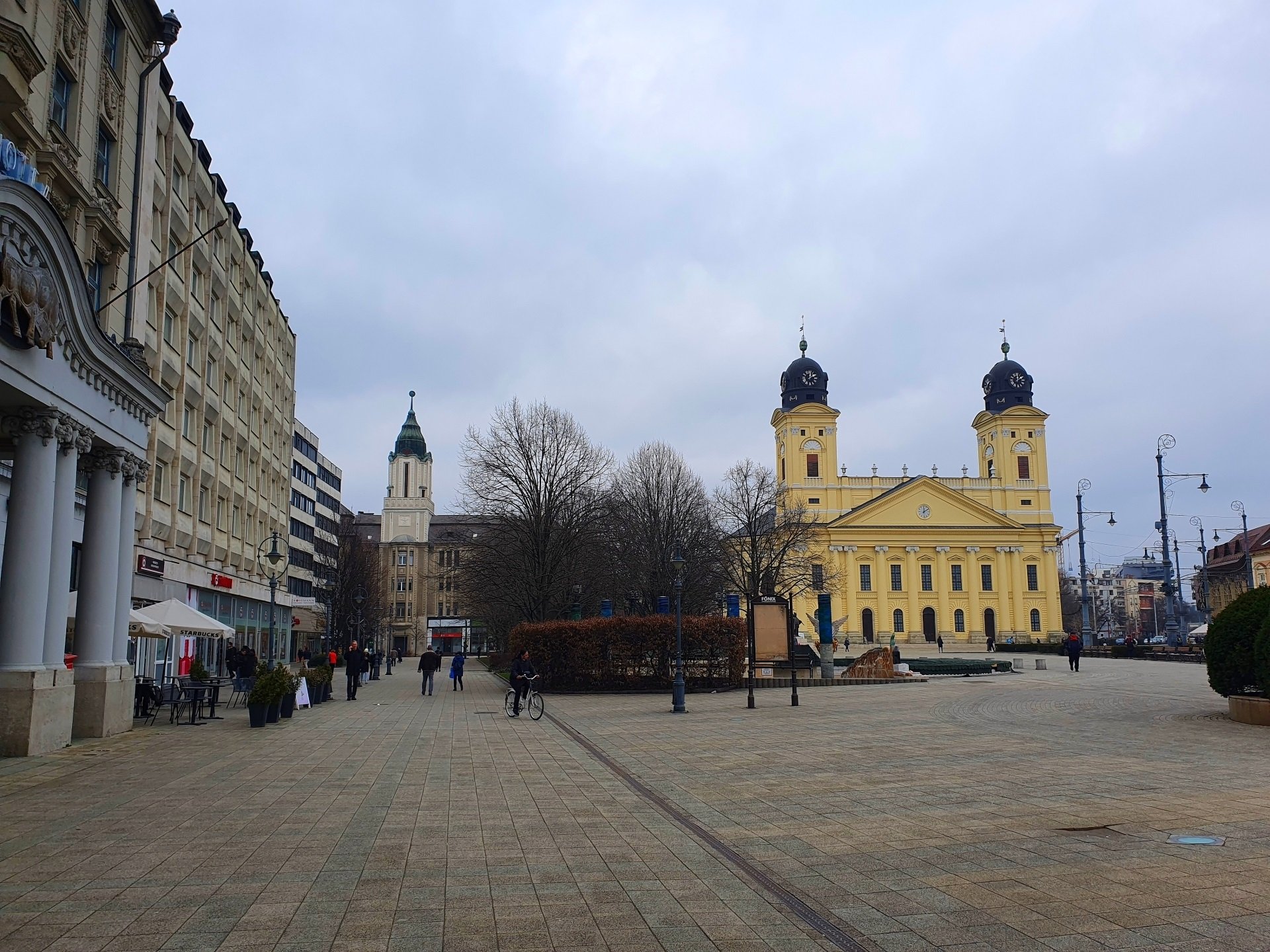
The other view towards the cathedral. To the left is the tower of the Bishop’s Palace or Püspöki Palota. In the center there is an atypical fountain, the Millennium Fountain or Millenniumi Szökőkút.
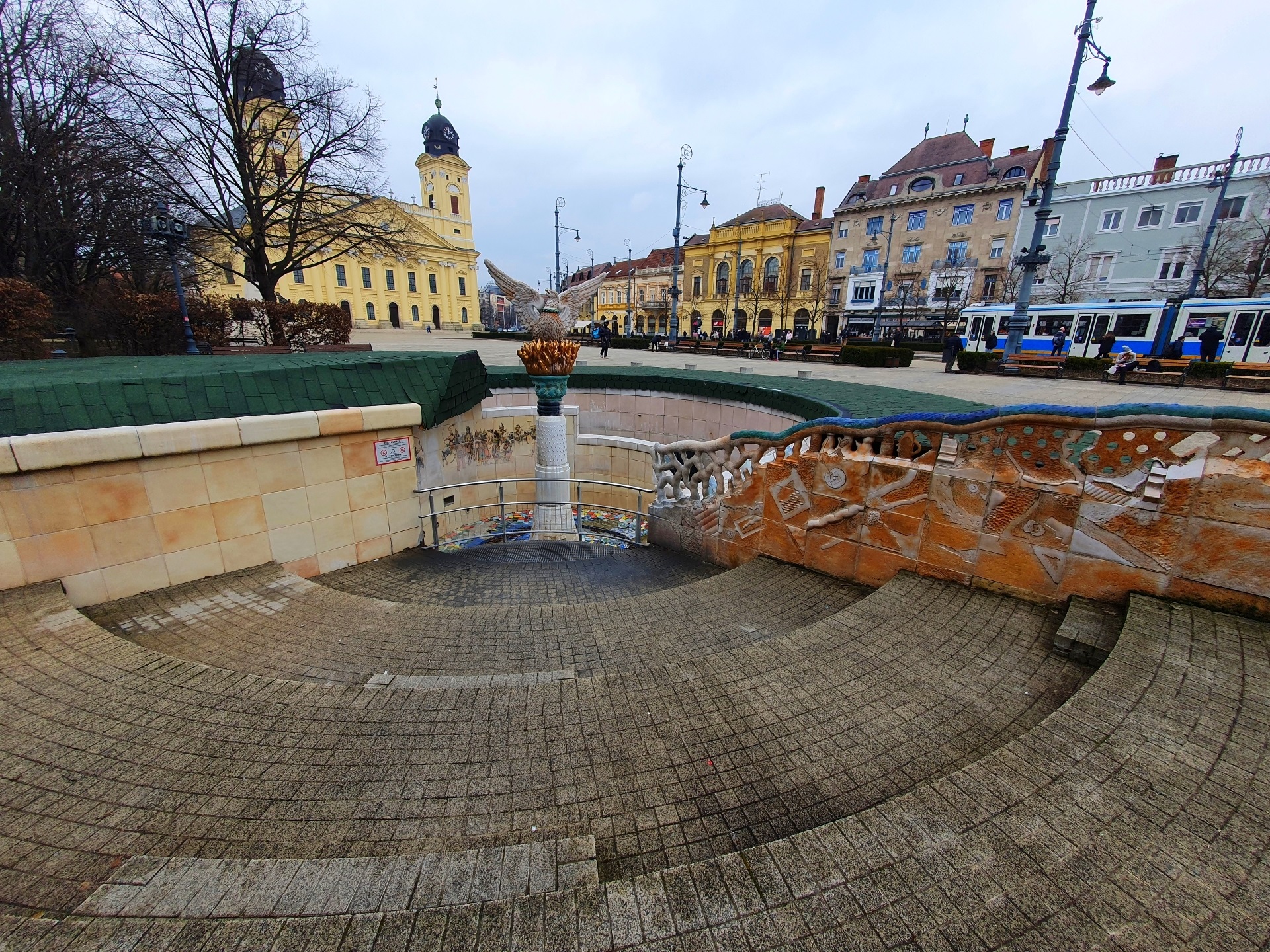
A detail of Millenniumi Szökőkút.

Close by in Kossuth Square (Debrecen főtere) is the colorful mosaic of the city coat of arms or Városcímer mozaikból. In the background is the big Lajos Kossuth Monument or Kossuth Lajos szobor.

The Bishop’s Palace or Püspöki Palota, exhibiting Art Nouveau elements (the building is decorated with Hungarian floral ornaments).
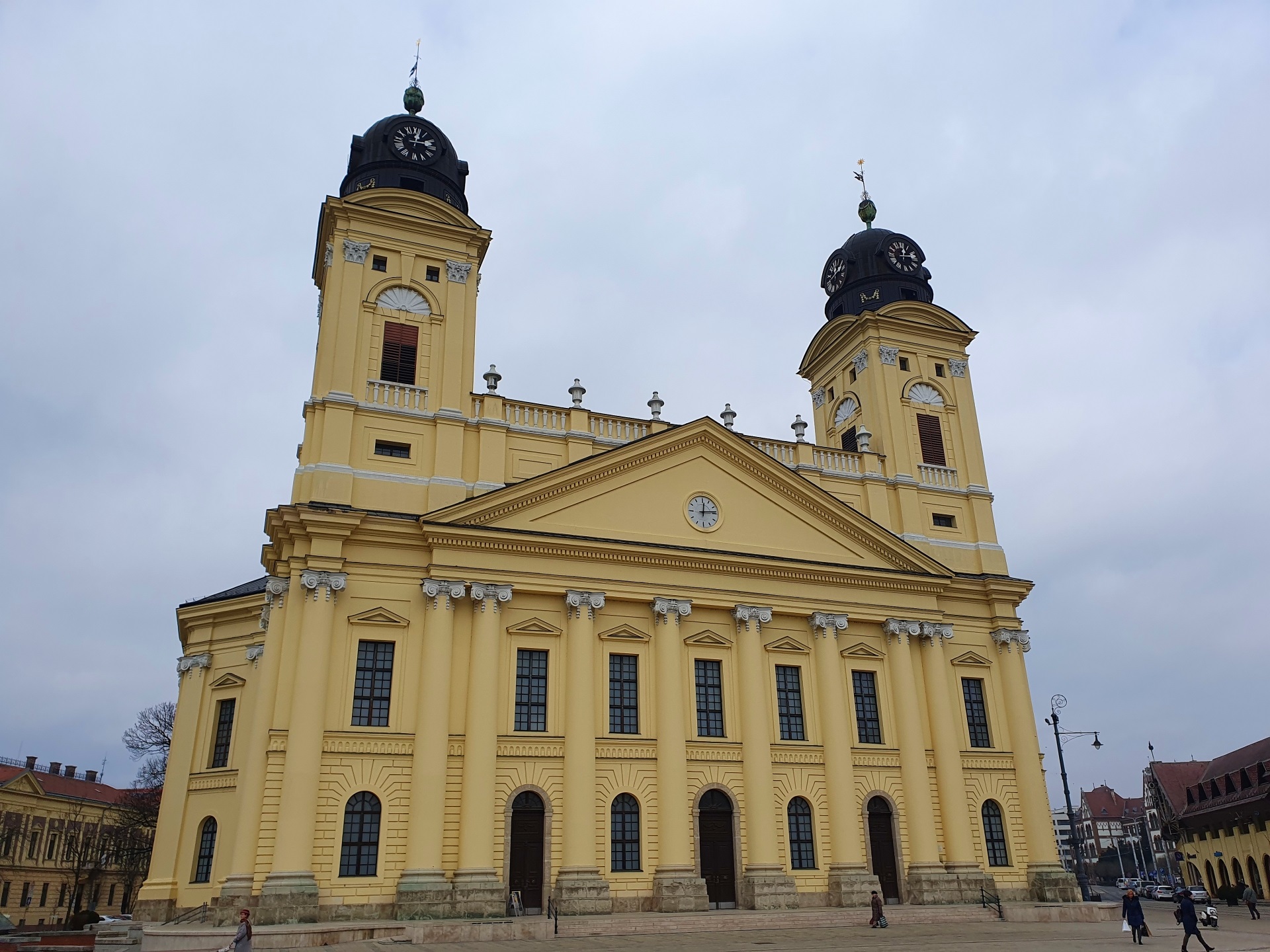
The façade of the Reformed Great Church of Debrecen or Debreceni Református Nagytemplom. This is probably the most recognizable sight of Debrecen. The church (I used the term cathedral in the article but it is actually a large church) is built in the Neoclassical style and dates from 1824. This is the headquarters of the Calvinist Church of Hungary, the eastern part of the country being heavily protestant. Actually, Debrecen is nicknamed “The Calvinist Rome” for a good reason; the architecture and the people in general are kind of emotionally retained, even austere, if you ask me…
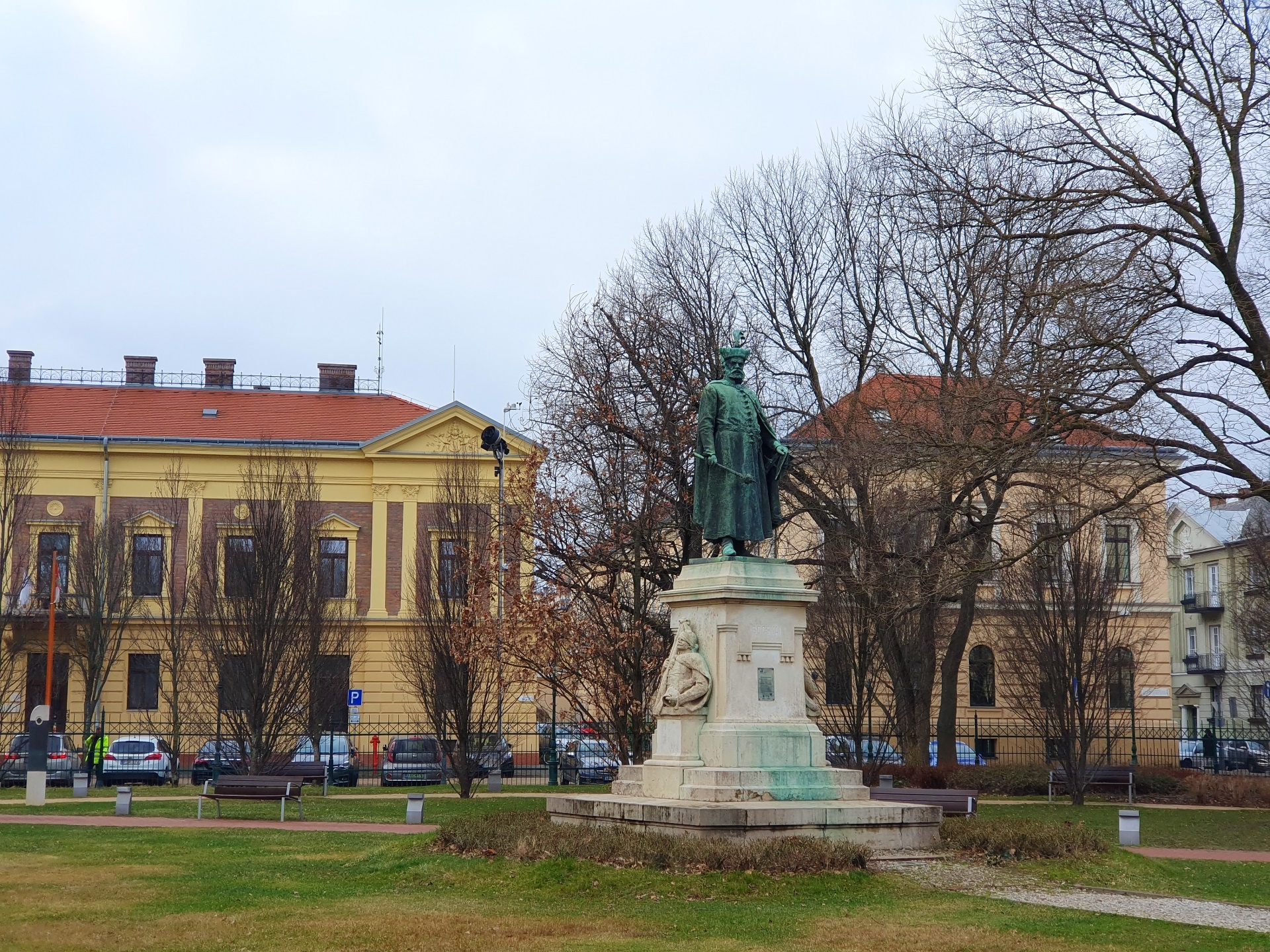
Behind the cathedral is Kalvin Square or Kálvin tér, with the Bocska statue or Bocskai szobor. István (Stephen) Bocskai was Prince of Transylvania and Hungary from 1605 to 1606 and he has an interesting connection with my home country, as he was born in Cluj-Napoca (Kolozsvár), he was captain of Oradea (Nagyvárad), had a tumultuous political career and life, and died in Alba Iulia (Gyulafehérvár). On the opposite side of the park is the Debrecen Reformed Theological University or Debreceni Református Hittudományi Egyetem, and the Reformed College Museum or Református Kollégium Múzeum. In the photo, behind the statue and to the left is the Bishop’s Office of the Tiszántúli Reformed Church District or A Tiszántúli Református Egyházkerület Püspöki Hivatala.
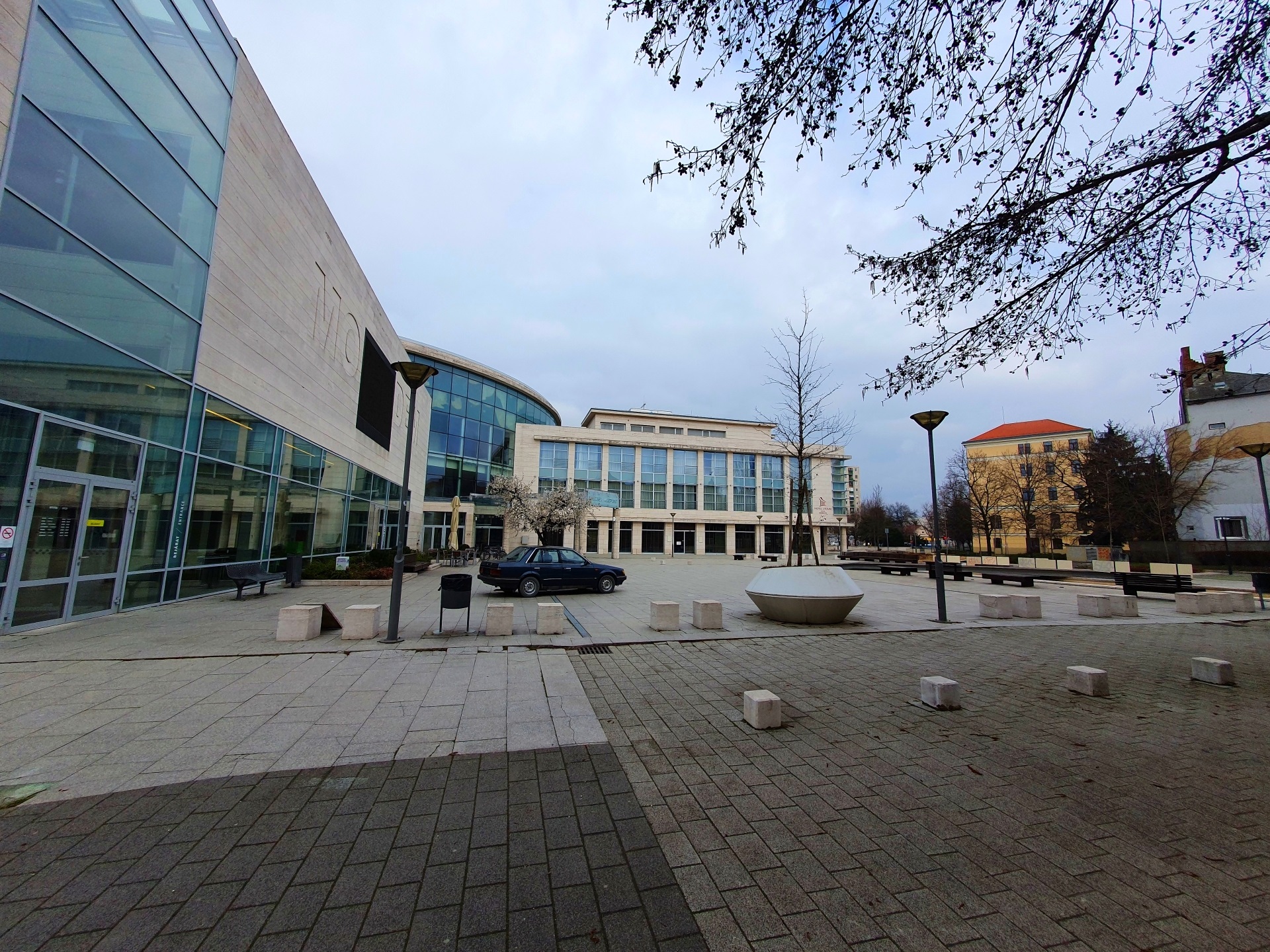
The Modem Centre for Modern and Contemporary Arts or Modem Modern és Kortárs Művészeti Központ in the Baltázár Dezső Square or Baltazár Dezső tér. The car in front of the building has a tree in blossom coming out of it in the most real way possible… I guess this is… art…

Déri Museum, one of the main sights of Debrecen, built in the Neo-baroque style in the 1920s. It hosts art, archaeological & ethnographic collections.
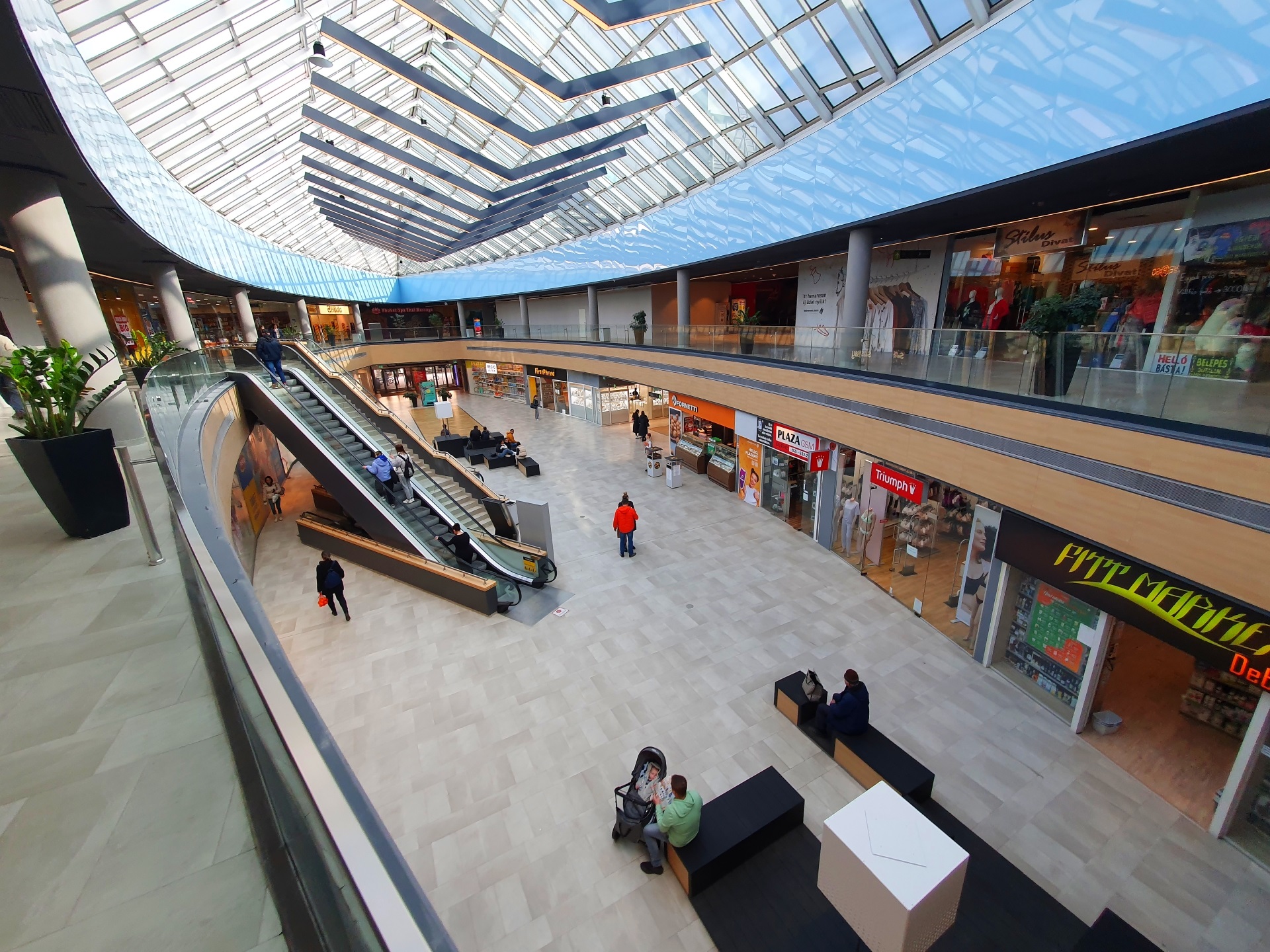
Inside the Debrecen Plaza (the smaller of the 2 shopping malls in the city center), a good spot to eat and relax. I personally preferred it to the other bigger mall.
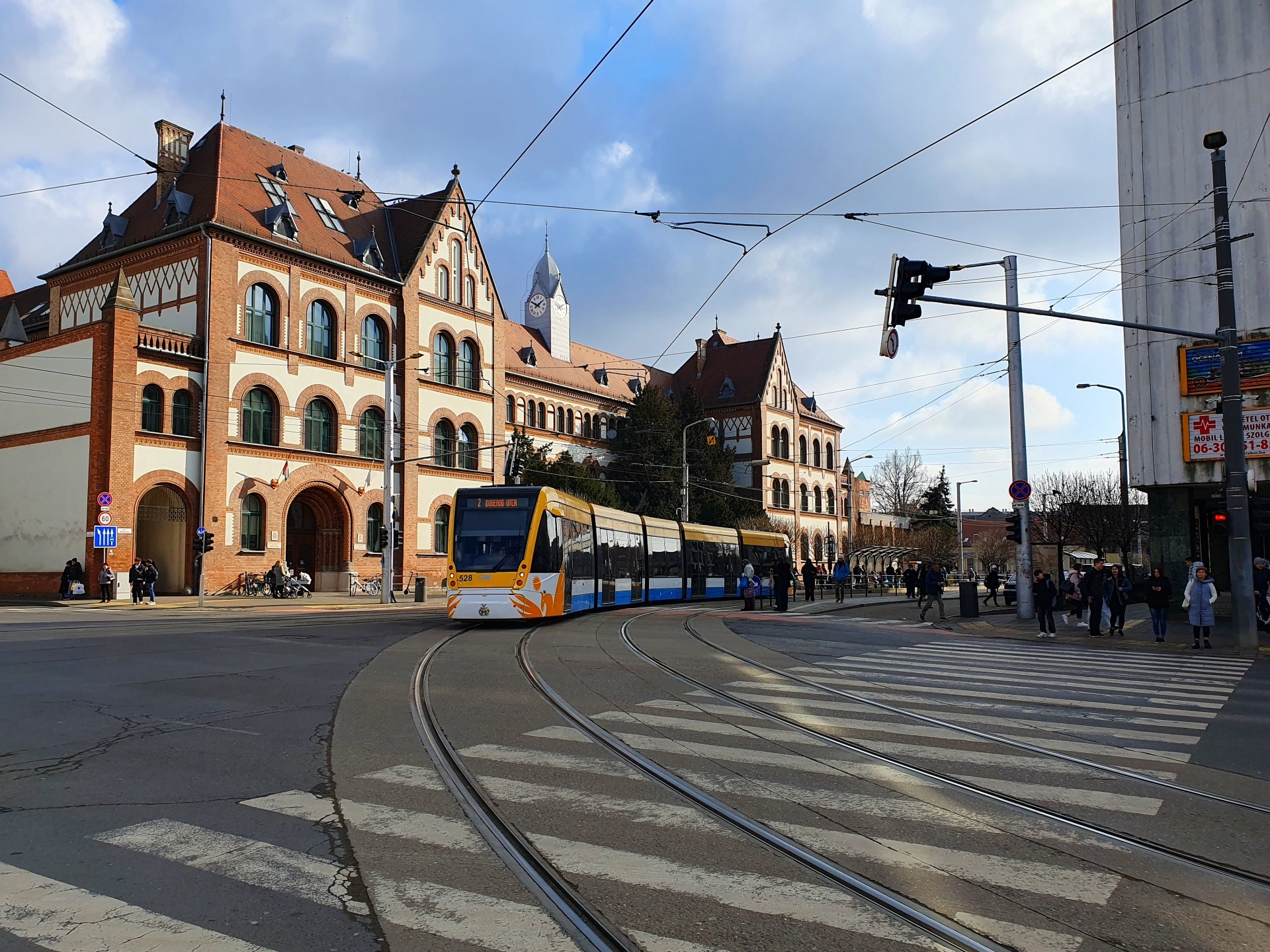
Crossing the street in front of the Debrecen Plaza, with the buildings of Debrecen Reformed College Elementary School and High School, or Debreceni Református Kollégium Általános Iskolája és Gimnáziuma, in the background.
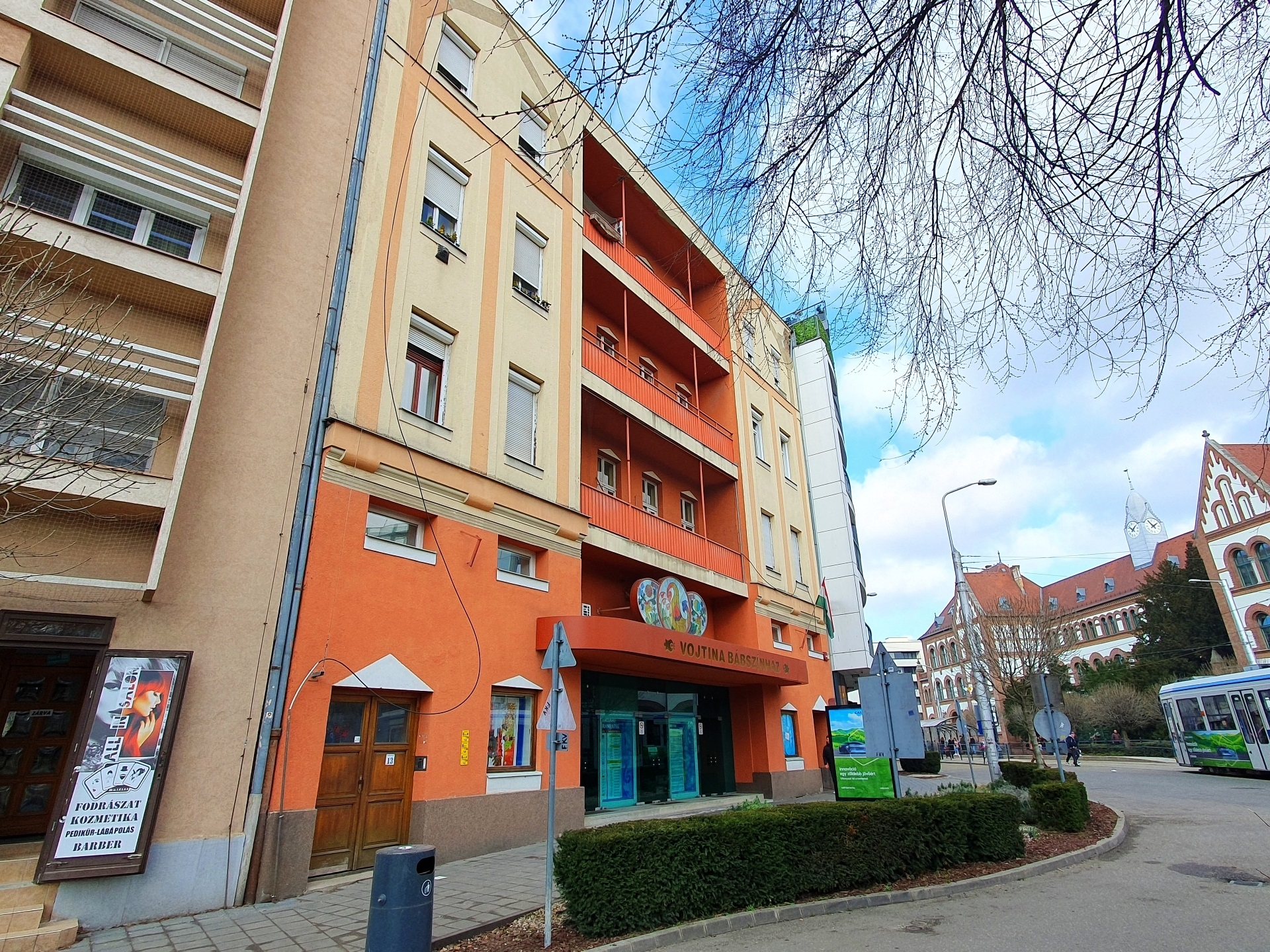
The Vojtina Puppet Theatre or Vojtina Bábszínház. When was the last time you went to a puppet theatre? Did you ever go to a puppet theatre? Just asking…
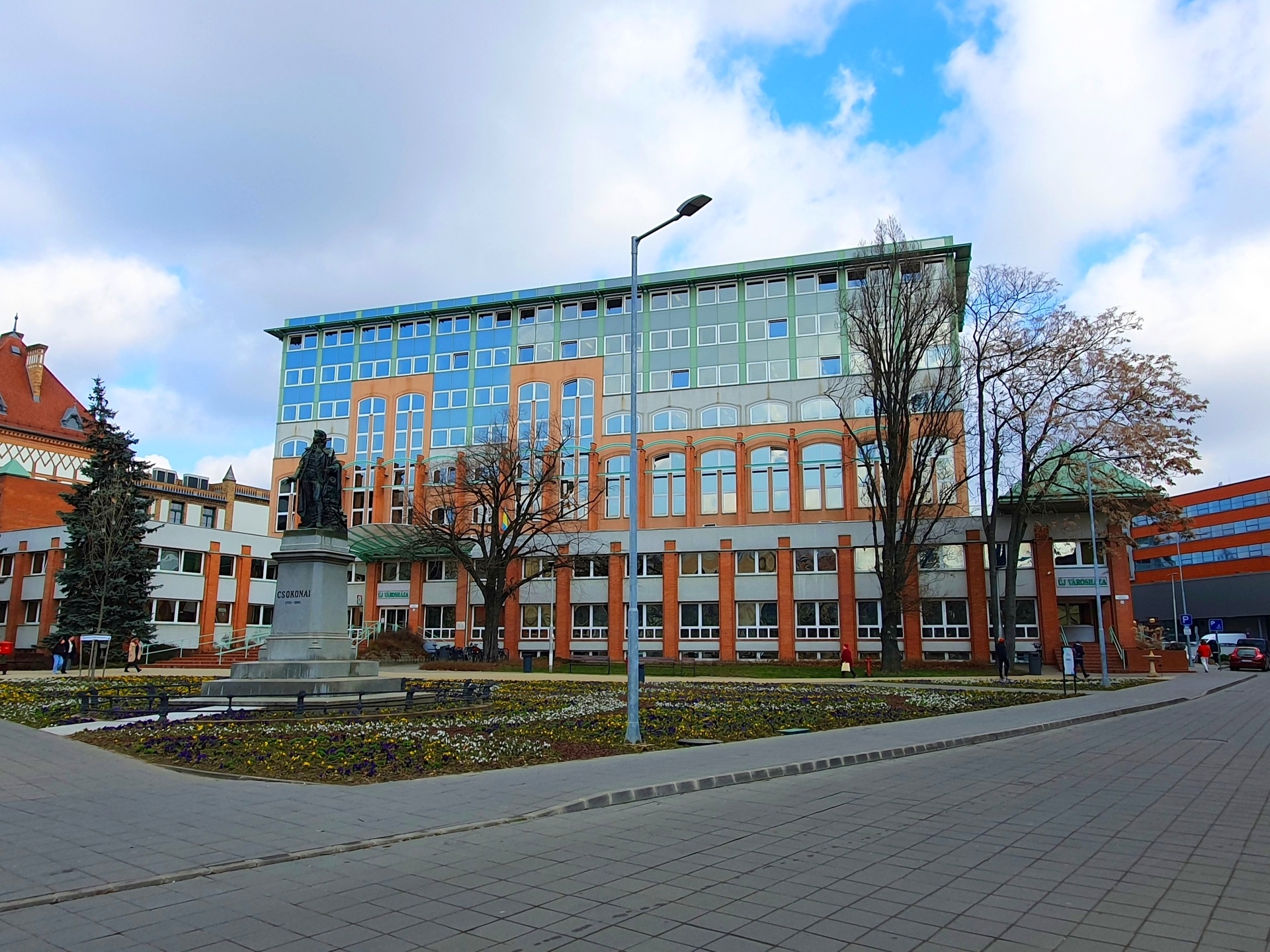
The building of Kormányablak (I have no idea what it is, probably linked to the local administration, since on the right corner it writes Új Városháza or the New City Hall). In front of it is the statue of Mihály Vitéz Csokonai or Csokonai szobor. Mihály Csokonai was a Hungarian poet, a leading figure in the Hungarian literary revival of the Enlightenment, being born, living and dying in Debrecen.
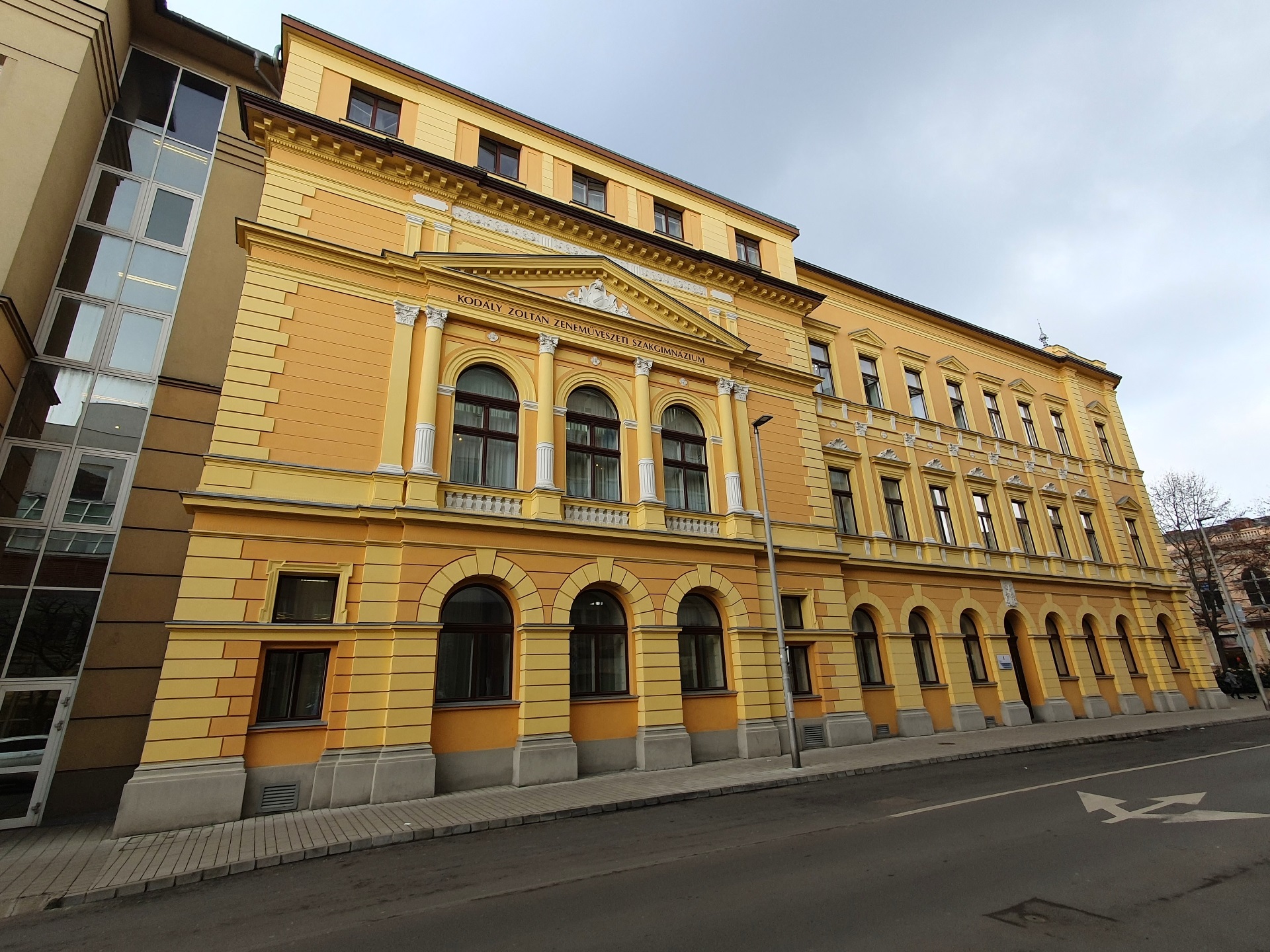
The Kodály Zoltán Secondary School of Music or Kodály Zoltán Zeneművészeti Szakgimnázium és Zeneiskola.
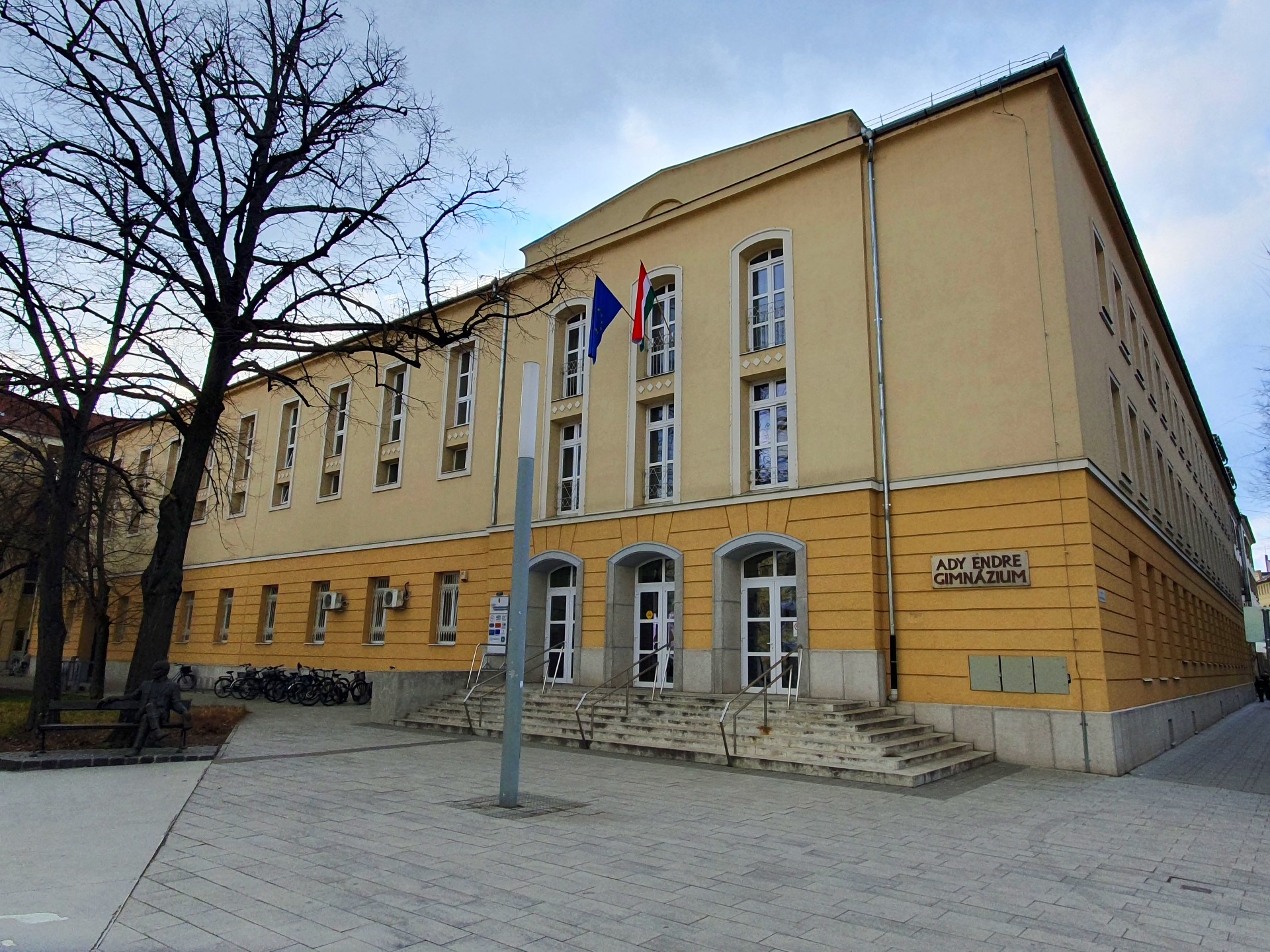
The Ady Endre High School in Debrecen or Debreceni Ady Endre Gimnázium in the Ady Park.
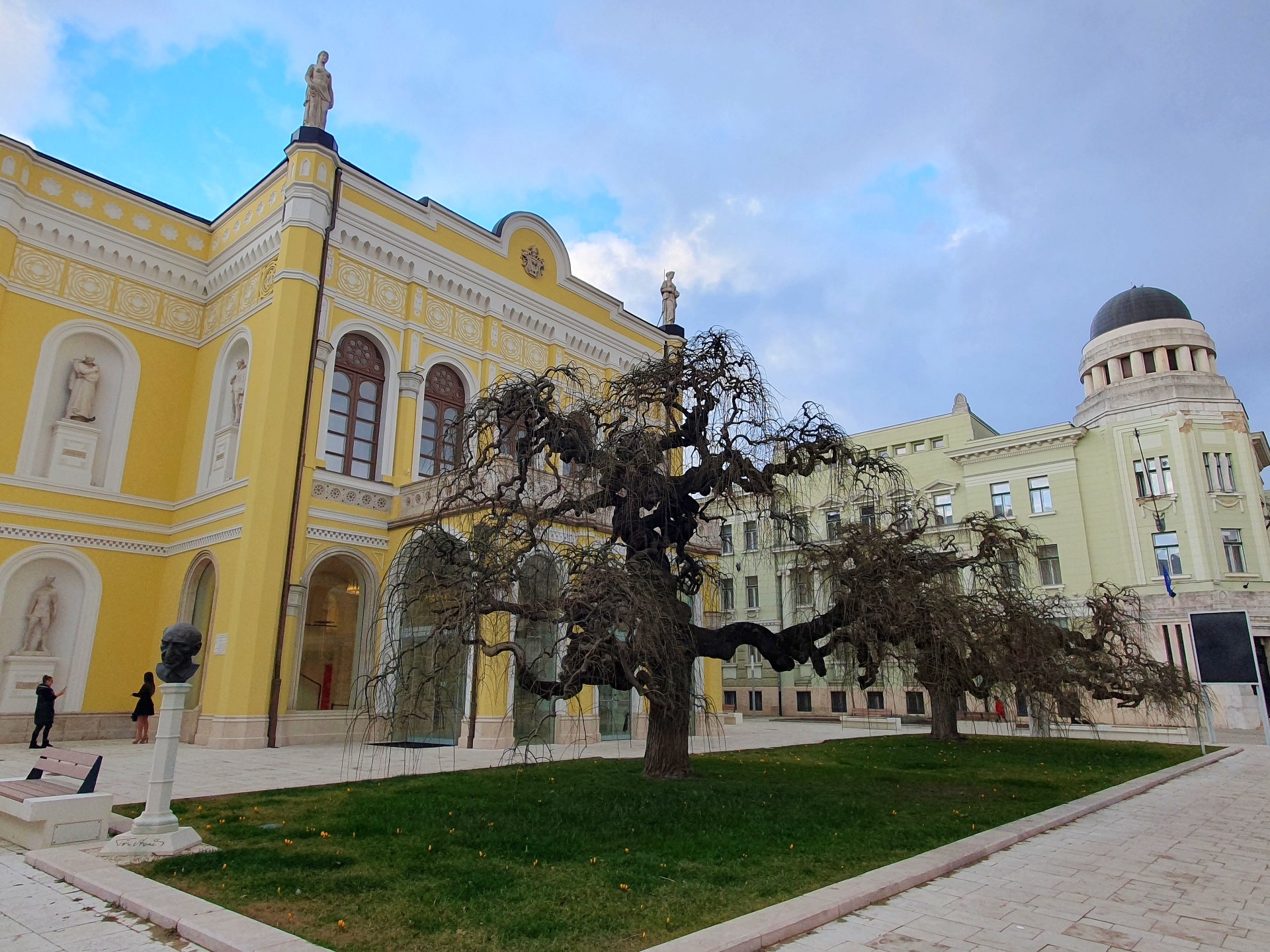
The Csokonai Theater or Csokonai Színház, another main sight of Debrecen. On the green grass in front of it there were yellow crocuses in bloom… The building to the right is the Hajdú-Bihar County Government Office Land Registry Department or Hajdú-Bihar Megyei Kormányhivatal Földhivatali Főosztály.
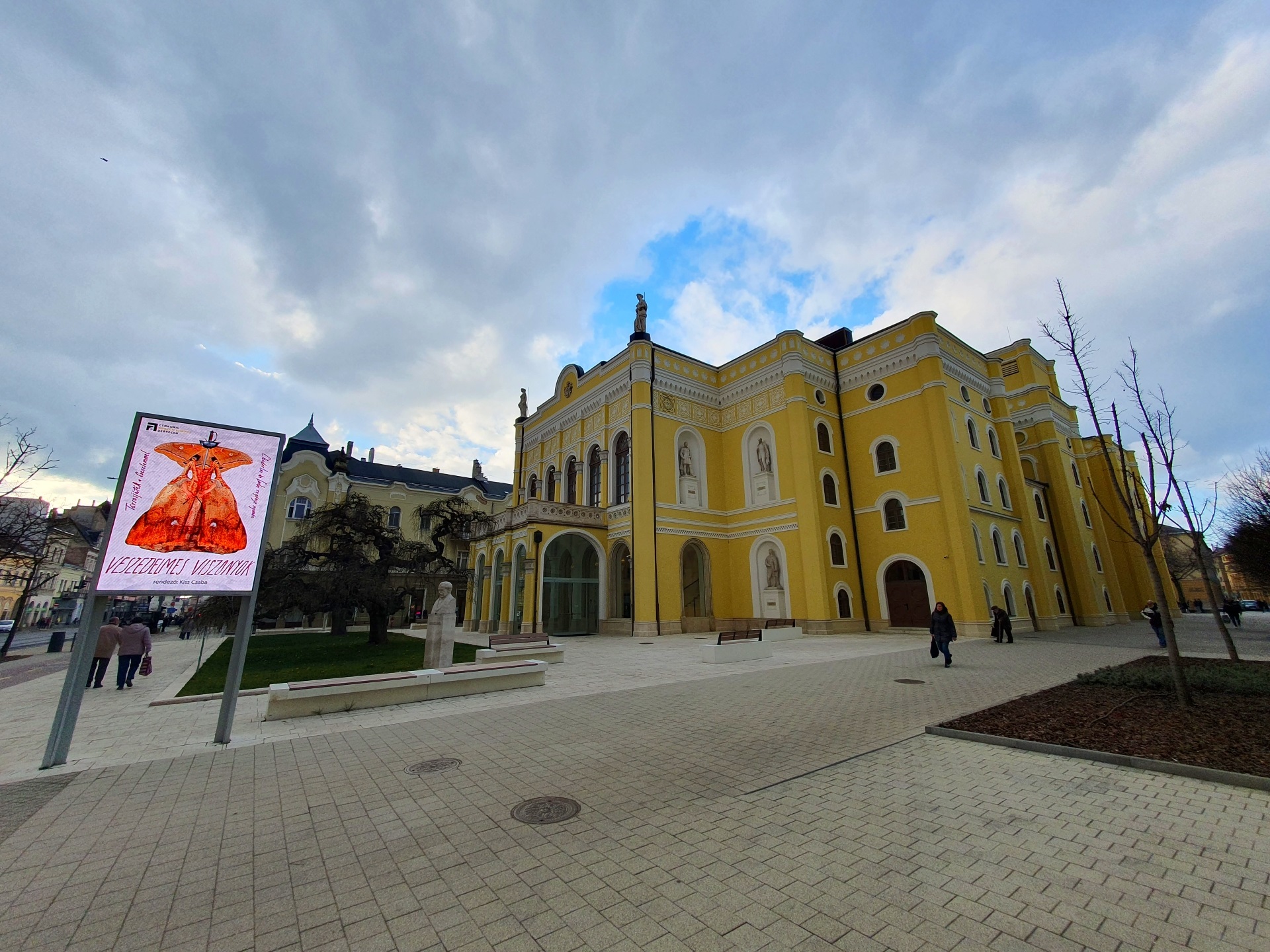
Another view of the theatre with Kossuth Street to the left.
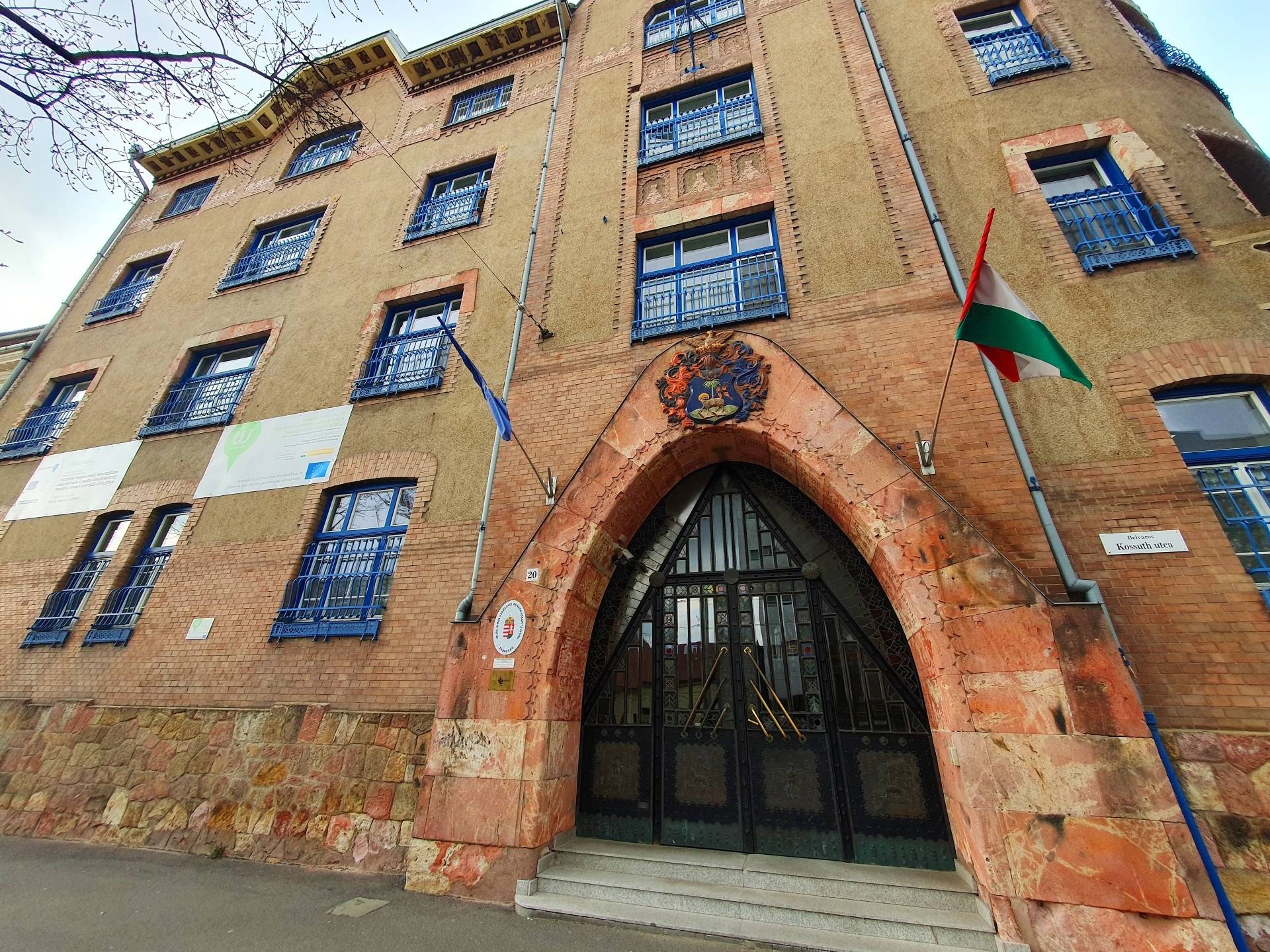
The Hajdu-Bihar County Police Headquarters or Hajdú-Bihar Megyei Rendőr-főkapitányság. I liked a lot the building and took the risk to photograph it (not sure if you can take a photo of a police office but Google Street view can, so… why wouldn’t I!?!).
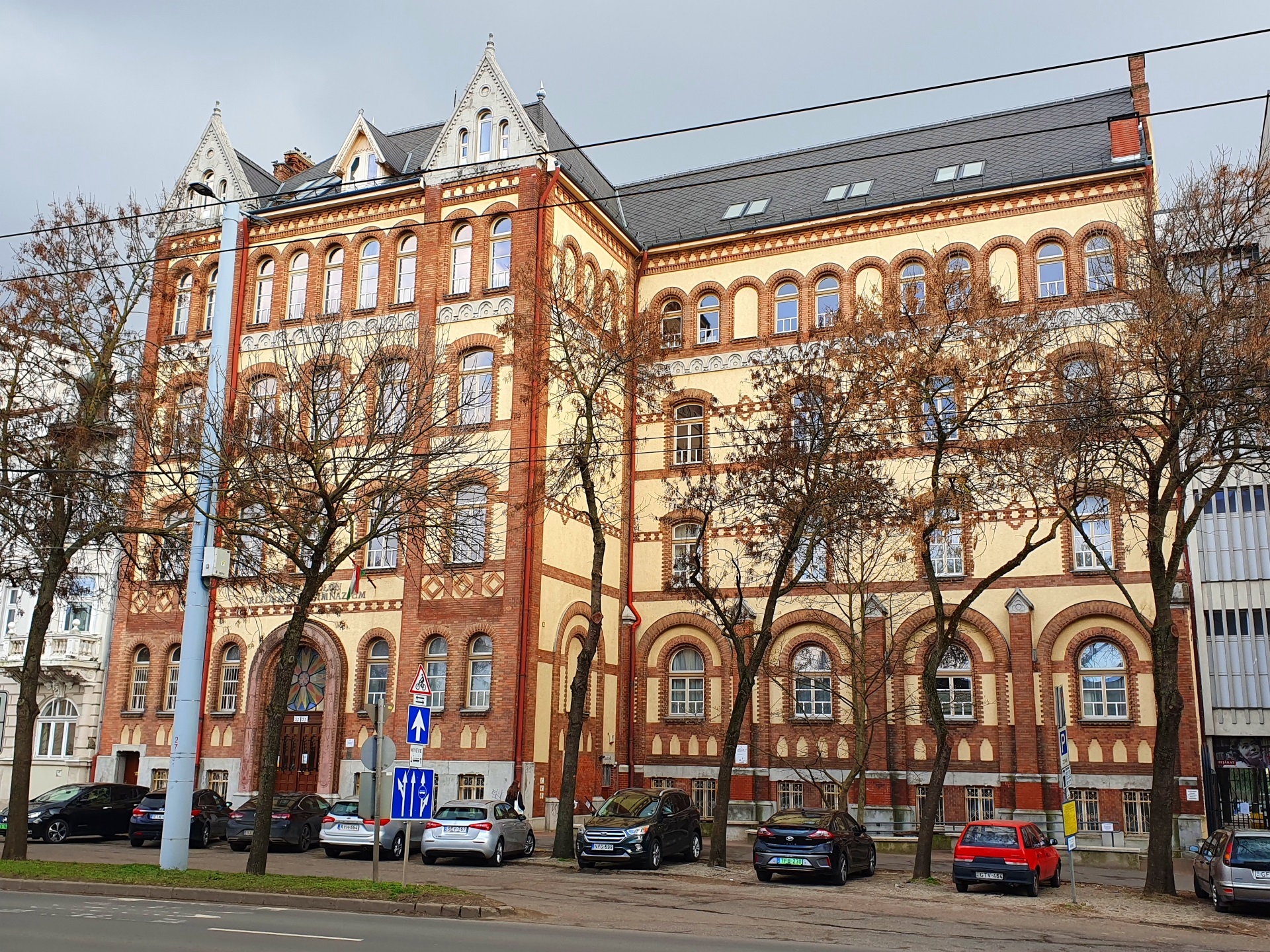
The Debrecen Reformed Dóczy College or Debreceni Református Kollégium Dóczy Gimnáziuma.
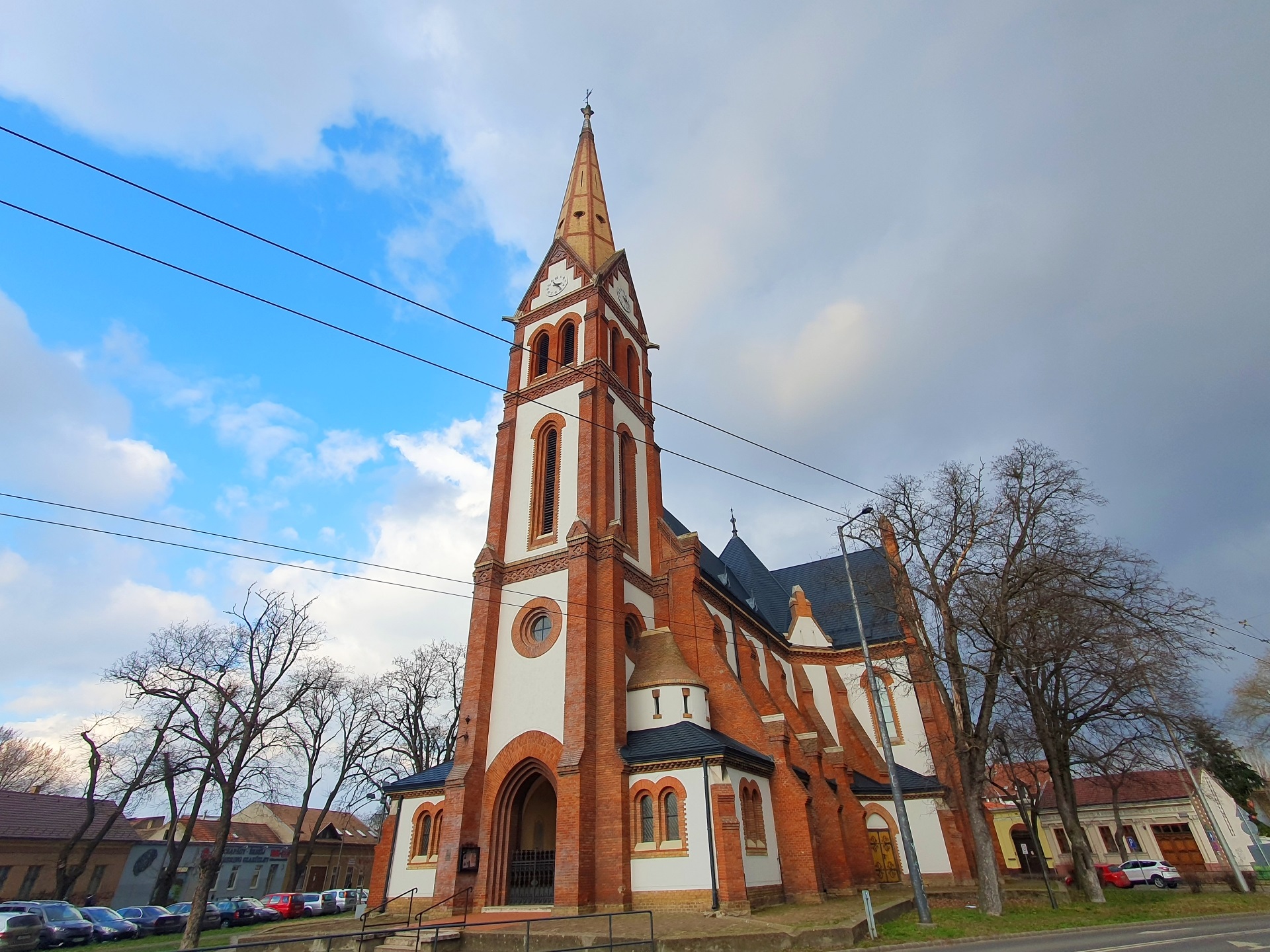
The Debrecen-Kossuth Street Reformed Parish Church or Debrecen-Kossuth utcai Református Egyházközség temploma.
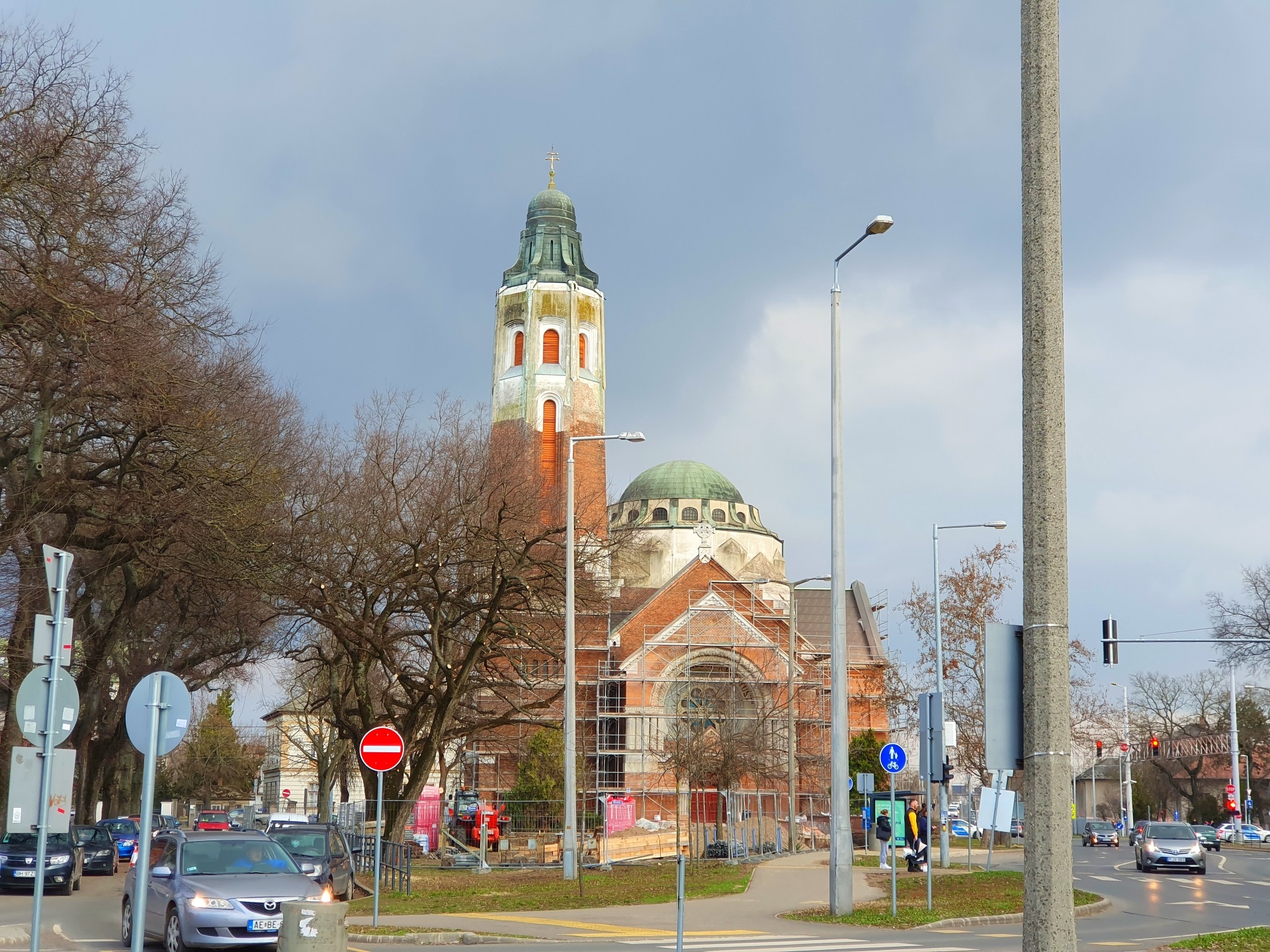
The Protection of the Theotokos Greek Catholic Church or Debreceni Görögkatolikus Templom, under under renovation.
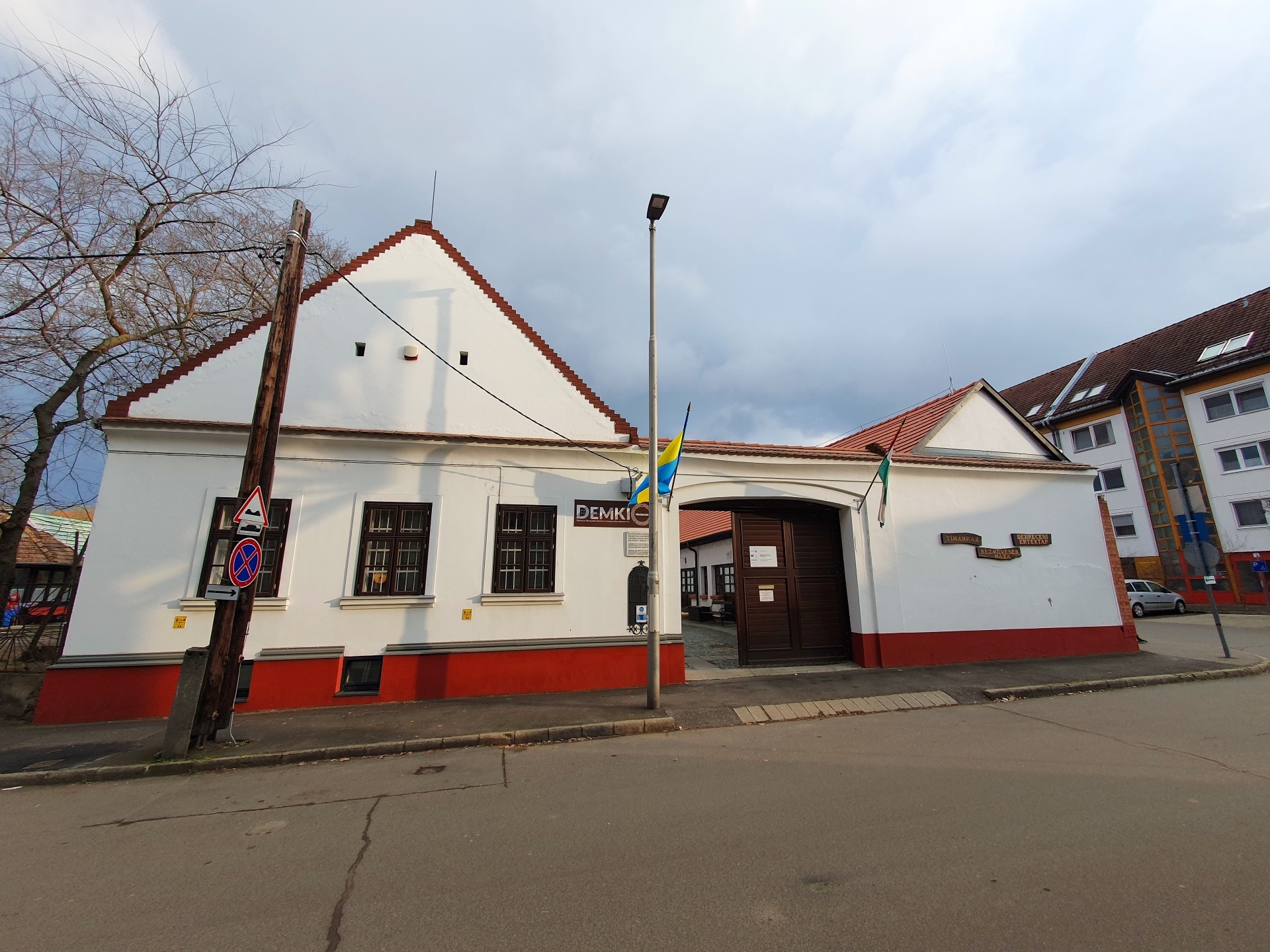
The Tanner’s House – House of Craftsmen or Tímárház – Kézművesek Háza.
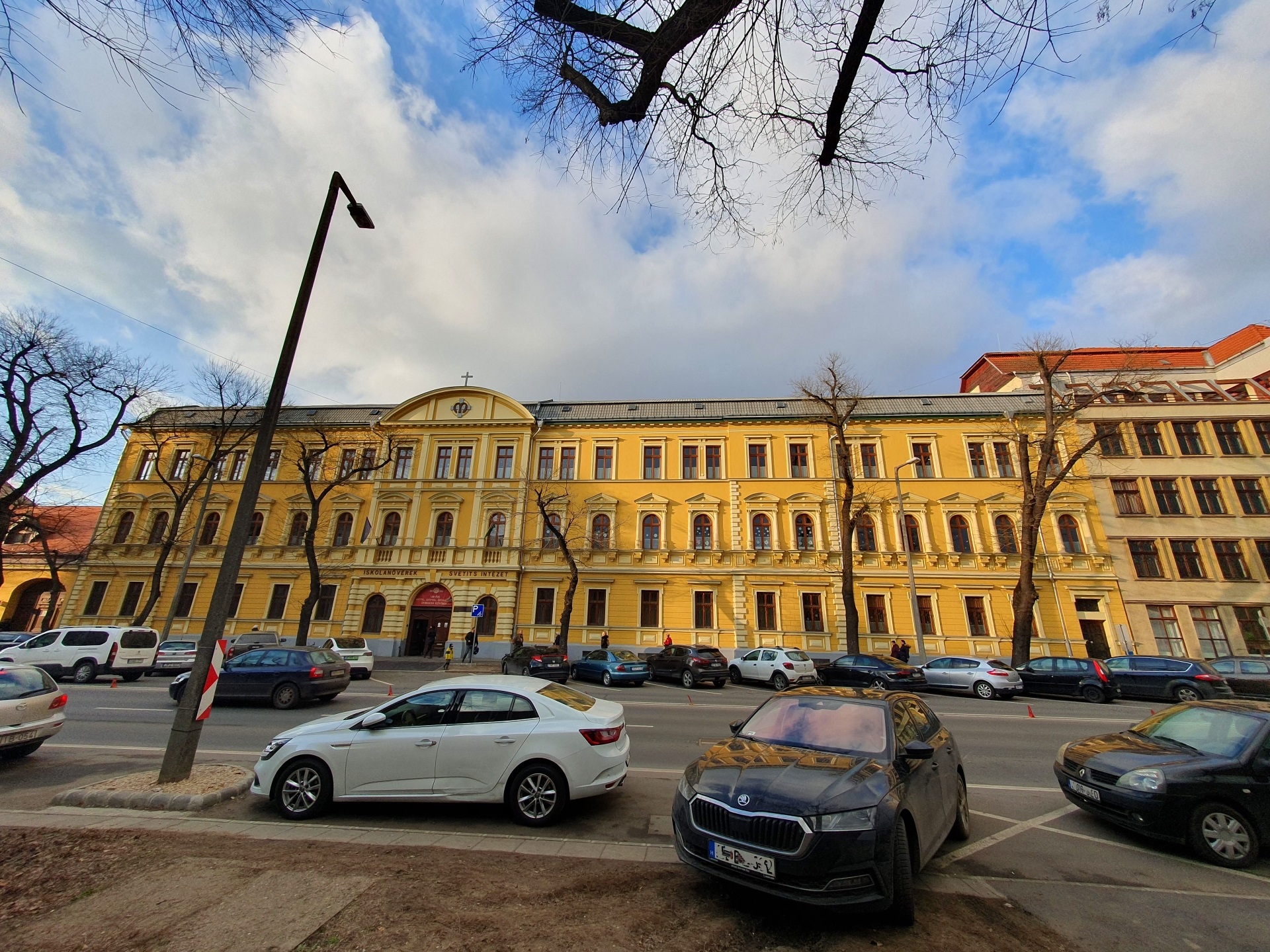
The Svetits Catholic Kindergarten, Primary School, High School and College or Svetits Katolikus Óvoda, Általános Iskola, Gimnázium és Kollégium, near and opposite the St. Anne’s Cathedral.

The Saint Anne’s Cathedral and main parish of Debrecen or Debreceni Szent Anna-székesegyház és főplébánia, the Catholic Cathedral where I could listen to some beautiful organ music. As a rule, the difference between the Catholics and the Protestants – from a tourist’s viewpoint – is that the Catholic churches/cathedrals are more open, free to visit and more beautiful, while the Protestant buildings are less architecturally beautiful and are almost always closed or asking for a visiting fee if open. This is also the rule in Transylvania and pretty much everywhere I travelled and where the 2 religious communities coexist. St. Anne Cathedral remains my favorite place in Debrecen, where I would return to meditate and perhaps enjoy some sacred music.
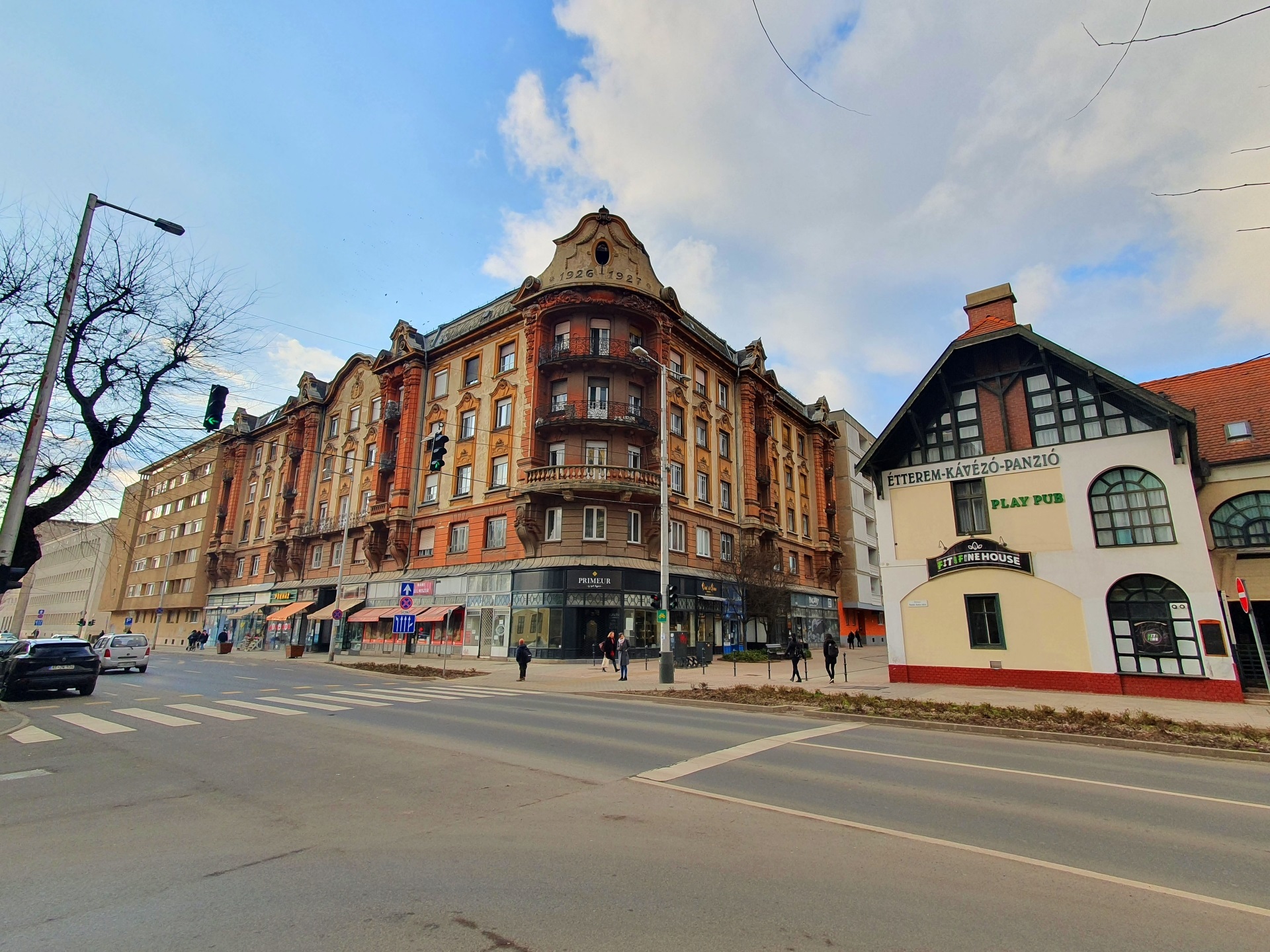
Across the cathedral is a nice historical building, built between 1926 and 1927 (as it states on its façade). Between it and the building to the right there is something interesting…
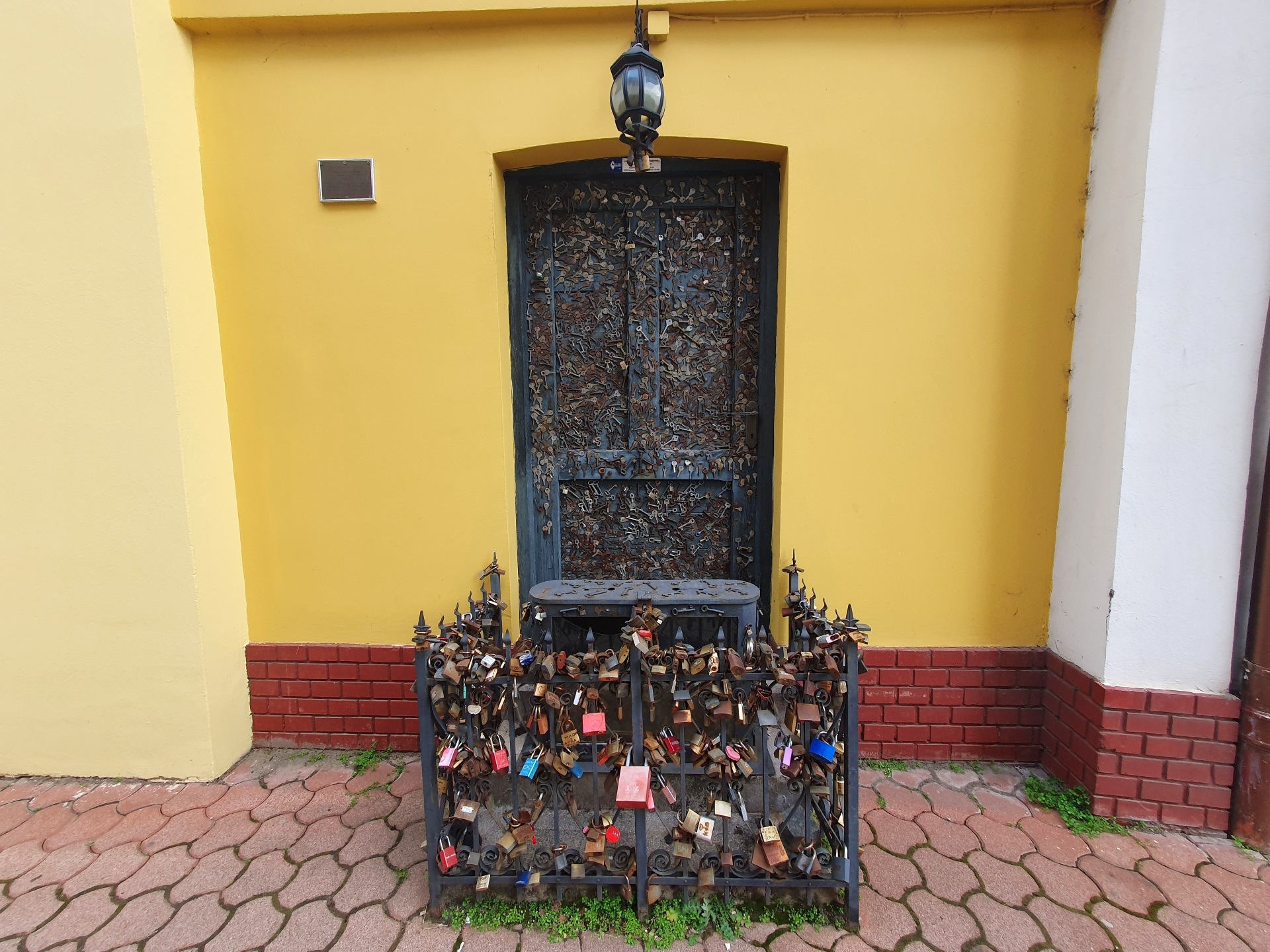
The Key wall or Kulcsos-fal. Well…
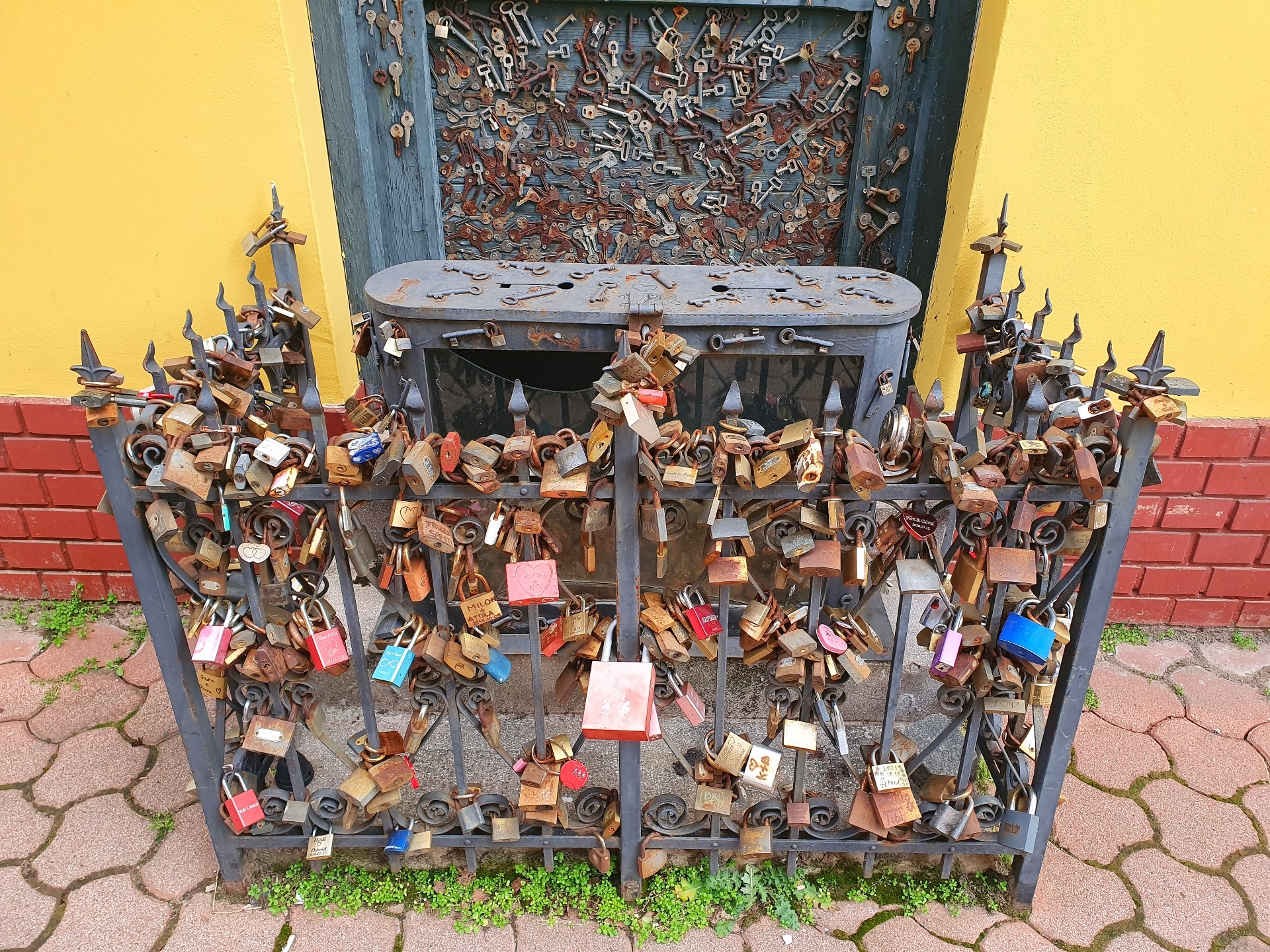
A detail of this bizarre… thing…

The Iparkamara Street, apparently a street considered beautiful… This is a house built in 1896…

A view of this Iparkamara Street from Petőfi Square (Petőfi tér), with the District Court of Debrecen or Debreceni Járásbíróság (to the right, the red tower), the Hajdú-Bihar County Correctional Institution or Hajdú-Bihar Megyei Büntetés-végrehajtási Intézet (basically the prison, the greyish corner to the extreme right of the photo) and the Chamber of Industry building (the house in the center of the photo, the only building that remained in Petőfi Square after the World War II American bombing).

We jump now to Széchenyi Street, where we can see the Hajdu-Bihar County Court of Registration or Debreceni Törvényszék.

And speaking of buildings that you don’t need to get to know if you have a normal life, here is the Debrecen Court of Appeals or Debreceni Ítélőtábla, and also the General Prosecutor’s Office of Debrecen or Debreceni Fellebbviteli Főügyészség. This building has a particular architectural style that makes you likely to avoid it…

On the other hand, the street in front of it is copy/paste of virtually any Transylvanian city or town. I felt like being back in Cluj-Napoca… It’s the common Austro-Hungarian heritage, style, mentality and so on…
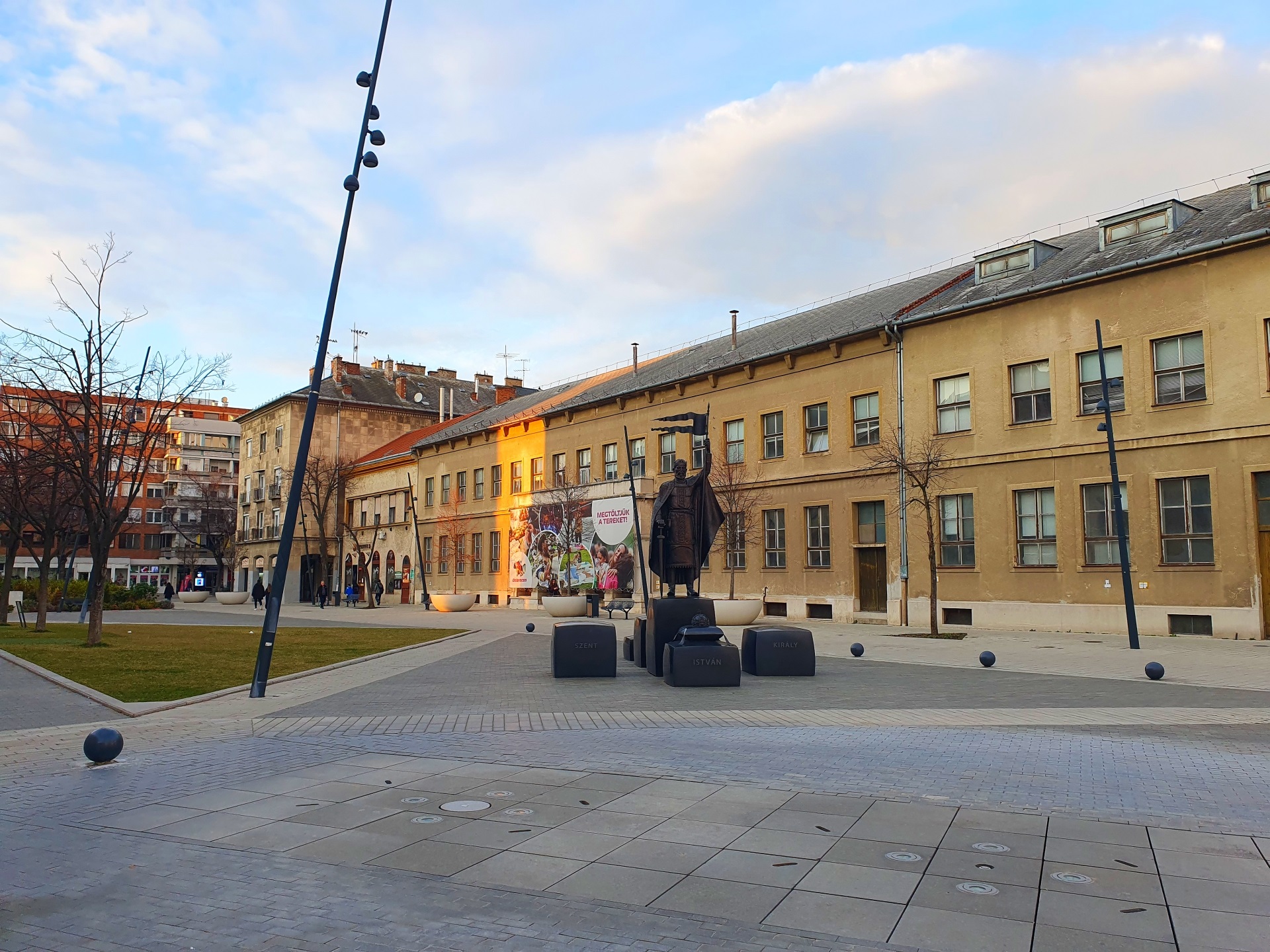
Back to downtown, the Statue of King Saint Stephen or Szent István király szobra in Dósa Nádor Square or Dósa Nádor tér.

From here one can take a long pedestrian road, the Csapó Street, until the Debrecen Forum (the bigger mall) and continue towards the outer parts of the city.
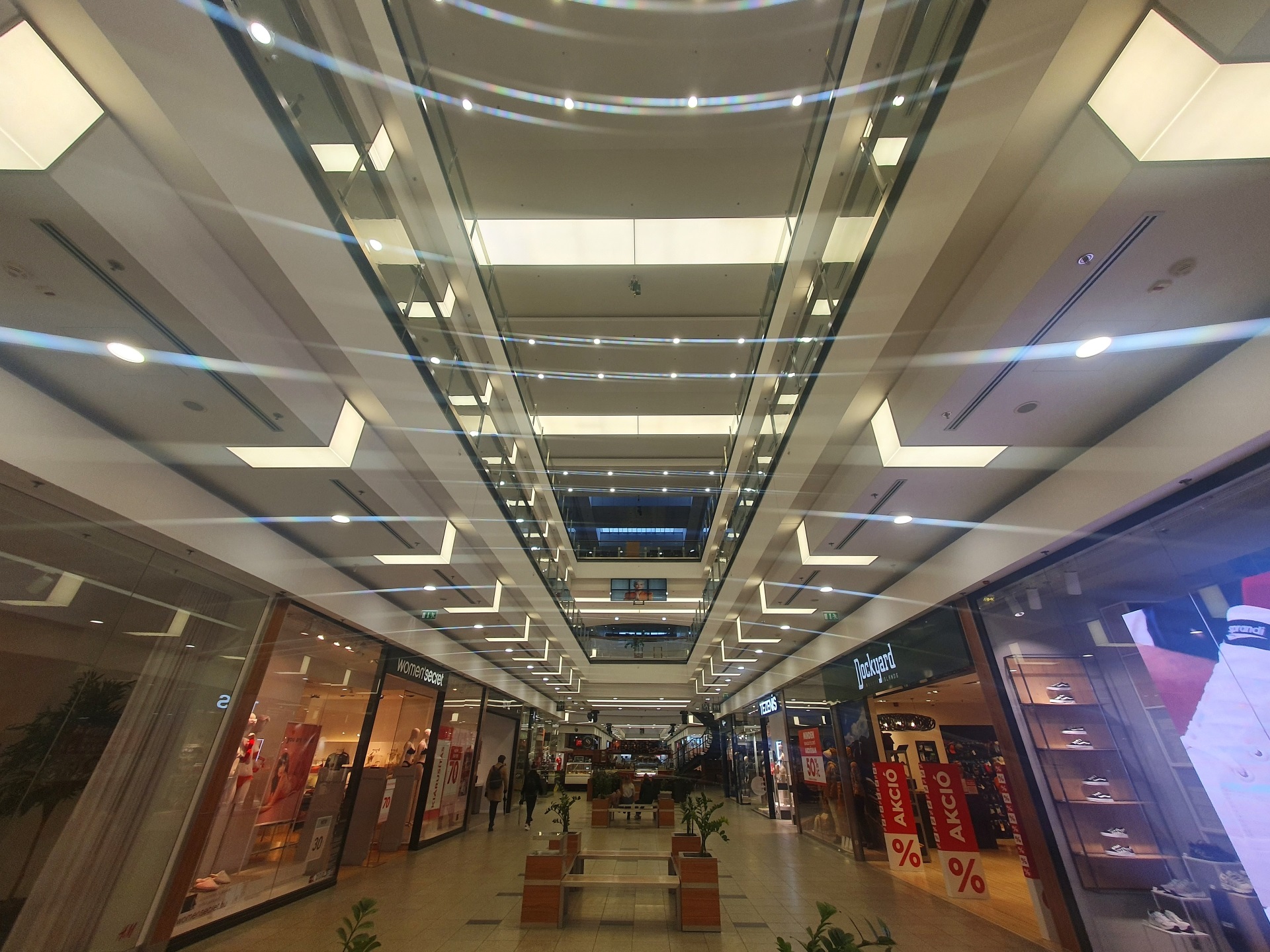
Debrecen Forum – the more modern mall…
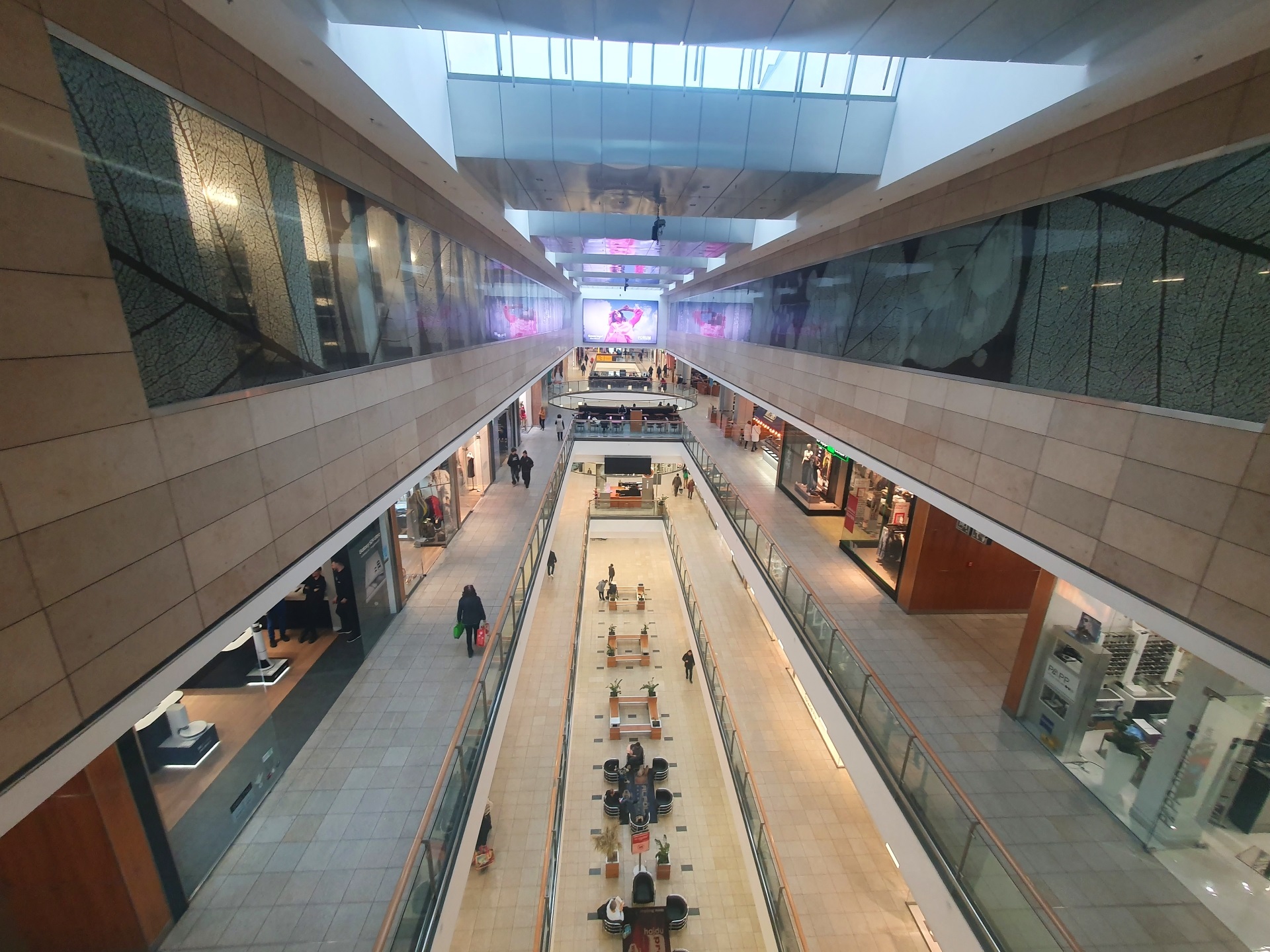
Also the bigger one…
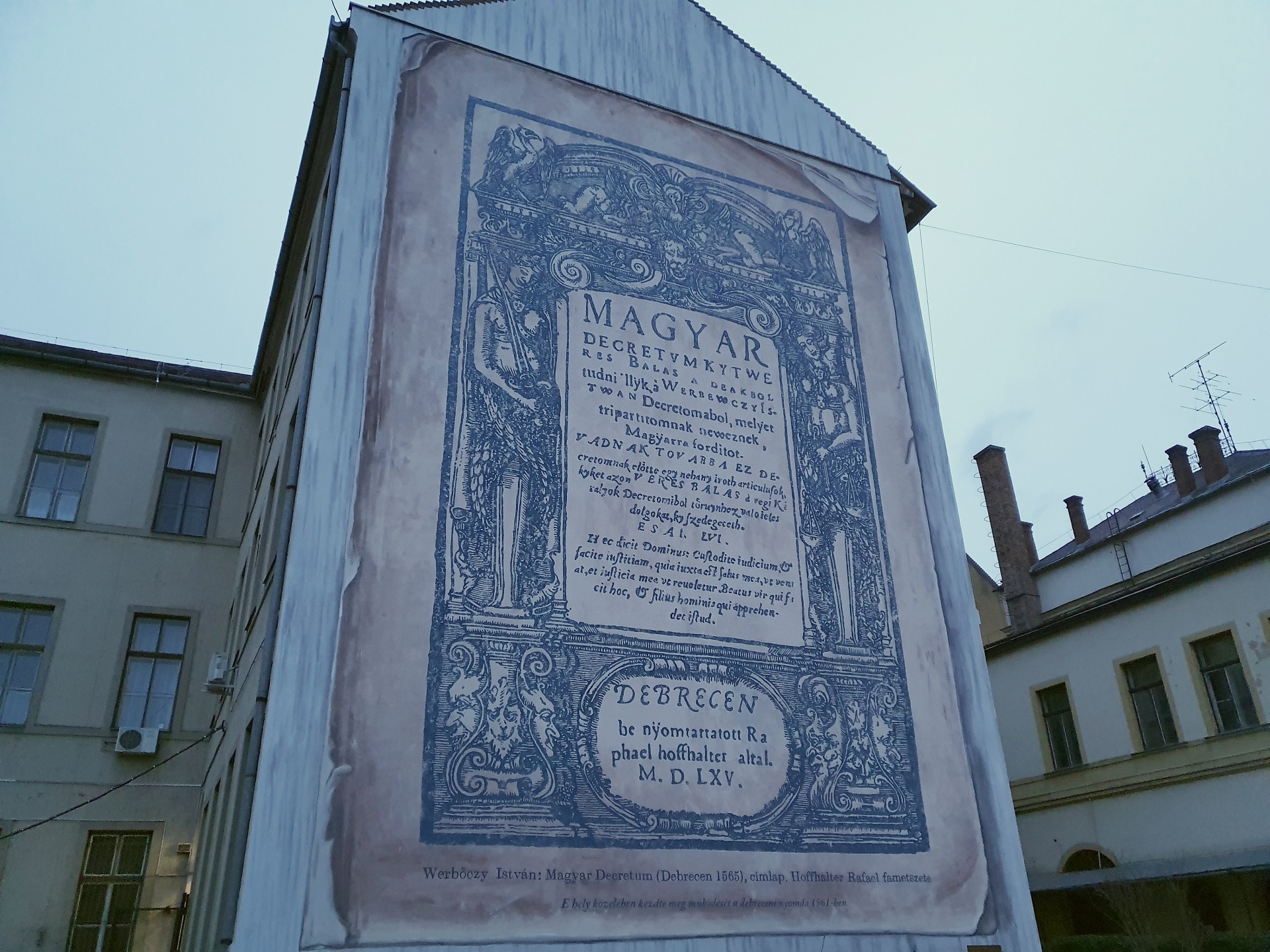
Yet, Debrecen’s vibe is more like the one transmitted by this mural painting on a building in the heart of the city, close to the hotel where I stayed.
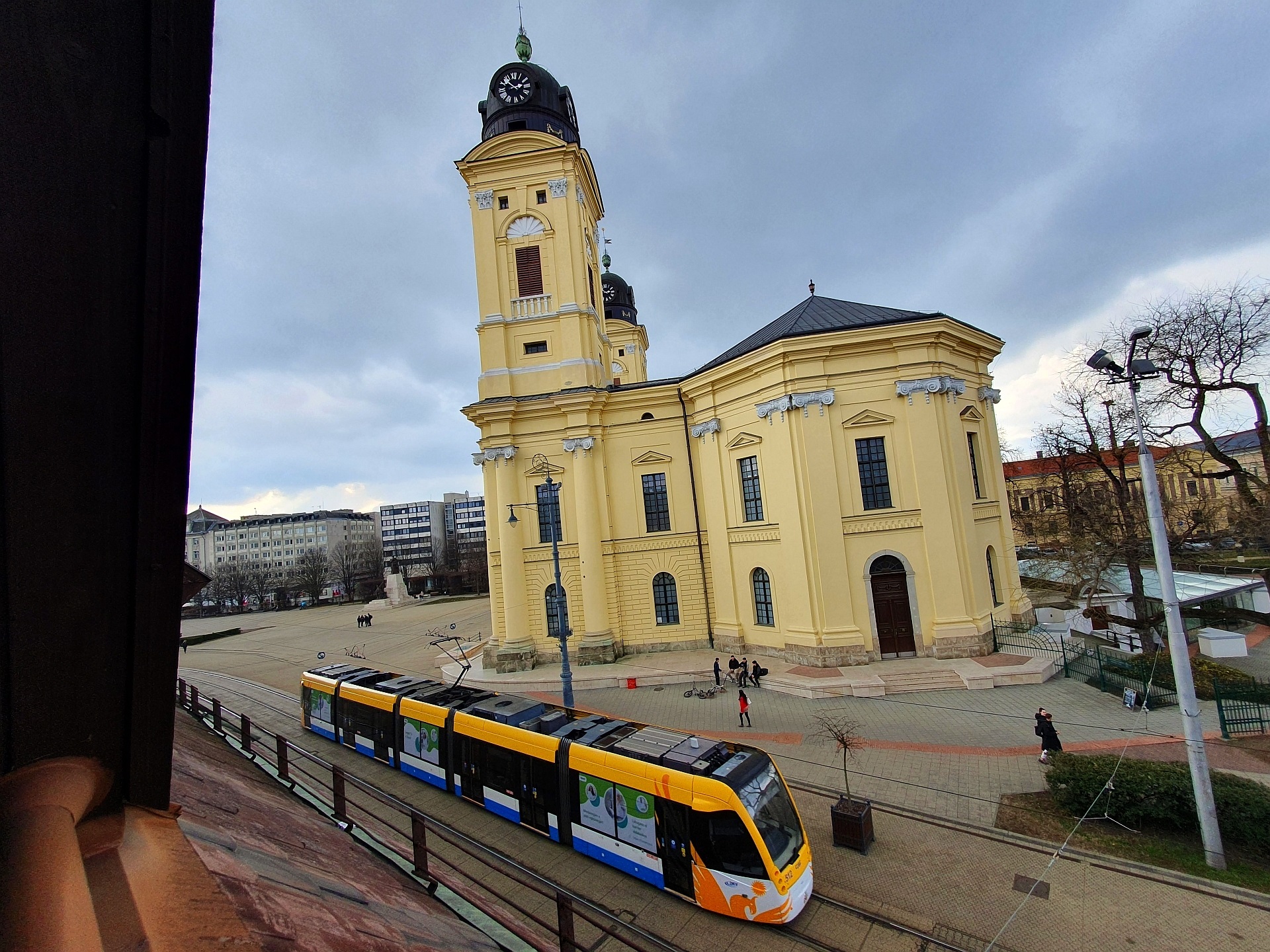
Here is the view from my room at Centrum Hotel. It’s been an off-season voyage I appreciated quite a lot, as a place can be better seen when it’s not crowded. Thanks for voyaging with me!
Debrecen
